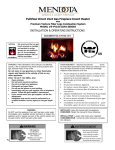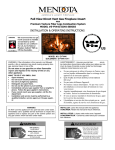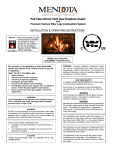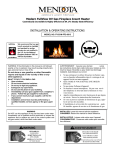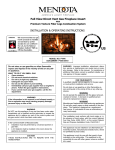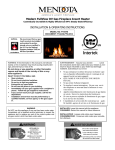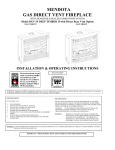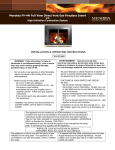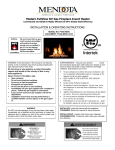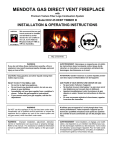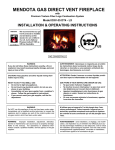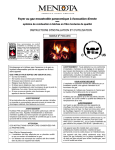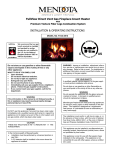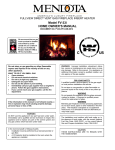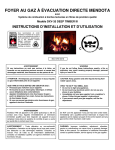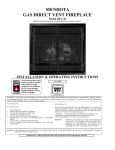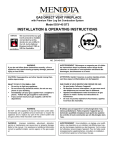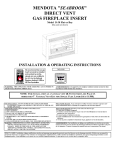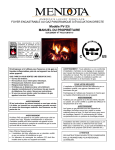Download Mendota FV33i-PF2-0113 Operating instructions
Transcript
FullView Direct Vent Gas Fireplace Insert Heater With Premium Texture Fiber Logs Combustion System INSTALLATION & OPERATING INSTRUCTIONS MODEL NO. FV33i-PF2-0113 Do not store or use gasoline or other flammable vapors and liquids in the vicinity of this or any other appliance. WHAT TO DO IF YOU SMELL GAS · Open windows. · Do not touch electrical switches. · Do not try to light any appliance. · Extinguish any open flame. · Do not use the phone in your building. · Immediately call your gas supplier from a neighbor's phone. Follow the gas supplier’s instructions. · If you cannot reach your gas supplier, call the fire department. WARNING If the information in this manual is not followed exactly, a fire or explosion may result causing property damage, personal injury or loss of life. WARNING Do NOT use this appliance if any part has been under water. Immediately call a qualified service technician to inspect the appliance and to replace any part of the control system and any gas control, which has been under water. CAUTION THESE INSTRUCTIONS ARE TO REMAIN WITH THE HOMEOWNER. In the Commonwealth of Massachusetts: · Installation must be performed by a licensed plumber or gas fitter; · A CO detector shall be installed in the room where the appliance is installed. WARNING: Improper installation, adjustment, alteration, service or maintenance can cause injury or property damage. Refer to this manual. For assistance or additional information consult a qualified installer, service agency or the gas supplier. FOR YOUR SAFETY A qualified installer, service agency, or the gas supplier must perform installation and service. Do not store or use gasoline or other flammable vapors and liquids in the vicinity of this or any other appliance. WARNING Do not operate this appliance with the glass removed, cracked or broken. A licensed or qualified person should do replacement of glass. WARNING Mendota gas fireplaces are heat producing appliances. Do not burn wood, paper or other materials in this fireplace. This fireplace is designed as a supplement heat source. It is advisable to have an alternative primary heat supply. The installation must conform with local codes or, in the absence of local codes, with the current National Fuel Gas Code, ANSI Z223.1, or the current Natural Gas and Propane Installation Code, CSA B149.1 This appliance may be installed in an aftermarket permanently located, manufactured (mobile) home, where not prohibited by local codes. This appliance is only for use with the type(s) of gas indicated on the rating plate. This appliance is not convertible for use with other gases, unless a certified kit is used. FV33i FEATURES - QUICK REFERENCE INFORMATION EXTERNAL DIMENSIONS: 30-3/8” Wide X 18-3/8” High X 15-3/4” Deep (depending on Surround return depth) 2 GLASS SIZE: NeoCeram Glass with non-reflective coating. Visible Glass measures 398 in . Actual Glass size is 2 468 in . MINIMUM FIREPLACE DIMENSIONS REQUIREMENT: 30-1/2 Wide X 18-3/8” High X 15-3/4” Deep MANTEL ALLOWANCE: 8” Deep Mantel at 12” Above Top Convection Opening Or 30-1/16” Above Floor Level Of This Appliance. Use the Approved Mantel Profile Chart. VENT SYSTEM ALLOWANCE: Vertical Terminations Only. 10 feet Vertical Minimum. 70 feet Vertical Maximum. 4” exhaust and 3” combustion air intake pipe adapter included with unit. Only the 4” vent pipe is required to be run the full length up to the chimney top adapter. The air intake 3” pipe may be “short-stubbed” above the existing chimney damper. Make certain to pack insulation in the existing damper area to block outside air from flowing through the damper. VENT DAMPER ADJUSTMENTS AVAILABLE: There are two vent system (air intake only) dampers installed in this appliance: · PRIMARY AIR INTAKE VELOCITY ADJUSTMENT DAMPER: This is located on the top of the Air Intake Starter collar. This is the Primary Air Intake Velocity Adjustment damper and adjustment of this damper must be made using a leverage tool such as a long screw driver. Factory adjusted to 45 degree Open, this is to be adjusted towards the closed position incrementally once the length of vent system increases past 20 feet only. Below 20 feet, leave at factory adjusted position. See page 52 for details. · SECONDARY AIR INTAKE ADJUSTMENT DAMPER: This is located above the glass frame in the top convection air cavity. Adjustment is to be made by loosening the securing nut then sliding to the right to close and to the left to open. This is Factory adjusted to Full Closed (all the way to the right). Leave this at this position for all installations. Adjust only in cases where more combustion air is needed to reduce rear flame height if rear flames are engulfing the baffle brick. See page 52 for details. CONTROLS: IPI Electronic Ignition System with AC Primary Power and DC Backup Power. Remote Control with Smart Thermostat included. Accent Light and Blowers operate on AC Power only. BLOWER SYSTEM: 210 CFM Dual Blower System. 120VAC, 2Amps. Dedicated Hot Power only. No switches, Fan Speed Controls or Light Dimmers are allowed in same circuit. Accent Light System: Accent Light System Included. Light can be turned on or off and dimmed from remote control. BURNER SYSTEM: Dual 304 Stainless Steel Tubular burners. BURNER SHUTTER SYSTEM: Externally controllable Rear Burner air shutter. Internal rotary Front Burner air shutter. LOG SET: 9-piece, Premium Definition Log Set. Extreme glow and realism ember bed. REFRACTORY PANELS: High Detail Red Soldier Course Fiber Brick Panels included. Brick Panels required for operation. NATURAL GAS INFORMATION: Factory equipped for Natural Gas. 4.5”WC Minimum inlet pressure required. For NG applications, Front Burner Orifice Size is #49 and the Rear Burner Orifice Size is #45. LPG INFORMATION: LP conversion kit #HA-82-00411 is required. 11”WC Minimum inlet pressure required. For the FV33i LPG application, both front are rear burner orifices are to be drill size 3/64”. For higher altitude, adjustment to orifice size may be necessary. 1 INITIAL STARTUP ADVICE PAINT CURING CYCLE RECOMMENDATION: It is recommended that you run this Insert on maximum flame height, with the blowers turned OFF, for 3 cycles of 2 hours ON and 2 hours OFF initially to cure the paint. BLOWER BREAK-IN PERIOD: The integrated blowers in this Insert may exhibit some bearing noise and electrical static noise during the first few hours of operation. This is normal during the break-in period. It is recommended that following the Paint Curing Cycle, the blowers be run at their maximum speed for two 3-hour periods. The burner flames may be on or off during these cycles. The blowers in a few inserts may take longer to break-in and may require additional operation time before all extraneous noise is eliminated. Please allow adequate operational time for the blowers to break-in before you contact your dealer for service. 2 TABLE OF CONTENTS FV33I FEATURES - QUICK REFERENCE INFORMATION ................................................................................................. 1 INITIAL STARTUP ADVICE .................................................................................................................................................... 2 SPECIFICATIONS ..................................................................................................................................................................... 4 SPECIFIC REQUIREMENTS FOR THE COMMON WEALTH OF MASSACHUSETTS........................................... 5 SAFETY AND WARNING INFORMATION ............................................................................................................................ 6 CONGRATULATIONS .............................................................................................................................................................. 7 BUILDING PERMIT AND INSTALLATION INSPECTION APPROVAL REQUIREMENTS....................................... 7 GENERAL INFORMATION...................................................................................................................................................... 8 FV33I OVERALL DIMENSIONS .............................................................................................................................................. 9 SPECIFICATIONS & CLEARANCES .................................................................................................................................... 10 INSTALLATION INSTRUCTIONS ........................................................................................................................................ 11 FLUE VENTING ...................................................................................................................................................................... 12 RAISED HEARTH SPECIFICATIONS ................................................................................................................................... 16 GAS SUPPLY REQUIREMENTS ............................................................................................................................................ 17 HIGH ALTITUDE INSTALLATIONS .................................................................................................................................... 19 ELECTRICAL REQUIREMENTS ........................................................................................................................................... 20 INSTALLATION CHECK OFF LIST ...................................................................................................................................... 21 LIGHTING CHECK OFF LIST ................................................................................................................................................ 21 DOOR REMOVAL AND REPLACEMENT ............................................................................................................... 22 OPERATING DURING POWER OUTAGES............................................................................................................ 35 “FIRST TIME” PILOT LIGHTING INSTRUCTIONS ................................................................................................ 36 IPI/STANDING PILOT SYSTEM INFORMATION .................................................................................................... 37 FV33I GAS IGNITION SYSTEM WIRING DIAGRAM ......................................................................................................... 38 MAINTENANCE...................................................................................................................................................................... 39 NATURAL TO LP GAS CONVERSION INSTRUCTIONS .................................................................................................... 40 LP PRESSURE REGULATOR CONVERSION INSTRUCTIONS ......................................................................................... 44 LP GAS PRESSURE REQUIREMENTS ................................................................................................................................. 45 CHECKING FOR NORMAL BURNER (S) IGNITION CHARACTERISTICS ..................................................................... 46 BLOWER OPERATION AND WIRING .................................................................................................................................. 47 CUSTOMER INFORMATION AND TROUBLE-SHOOTING .............................................................................................. 48 TROUBLE SHOOTING MENDOTA GAS FIREPLACE INSERT ......................................................................................... 48 BURNER FLAMES ADJUSTMENT- AIR INTAKE DAMPER CONTROLS ........................................................................ 49 BURNERS AIR SHUTTER CONTROLS ................................................................................................................................ 50 BASIX SURROUNDS AND FACEPLATES INFORMATION ................................................................................... 51 BACKUP DC POWER INLET CONNECTOR MOUNTING INFORMATION ........................................................... 52 REPLACEMENT AND SERVICE PARTS .............................................................................................................................. 55 MENDOTA EXTENDED PROTECTION AND LIMITED WARRANTY .................................................................... 59 3 SPECIFICATIONS MODEL FV-33i Input rating (Btu/hr) 0-610 m Minimum input (Btu/hr) 0-610 m Orifice size (DMS) 0-610 m (front/rear) Manifold pressure (in. w.c./kPa) > High Fire Manifold pressure (in. w.c./kPa) >Low Fire Minimum inlet pressure (in. w.c./kPa) Air shutter settings (in) Natural Gas 31,000 10,000 49/45 3.5/0.87 1.7/0.42 5.0/1.24 1/16” Propane Gas 31,000 13,000 3 3 /64”/ /64” 10.0/2.49 6.3/1.57 11.0/2.74 ¼” EFFICIENCIES ................................ .EXCEEDS D.O.E. EFFICIENCY REQUIREMENTS (A.F.U.E.) FLUE VENT LINER ........................... .CO-LINEAR - 4” DIAMETER EXHAUST & 3” DIAMETER INLET ..................................................... Minimum Vent Length is 10 feet. Maximum Vent Length is 70 feet. NET WEIGHT .................................. .165 lbs. SAFETY .......................................... .AGA CERTIFIED, ELECTRONIC IGNITION IPI SYSTEM ACTIVATED WITH THERMOSTATIC REMOTE CONTROL. GAS REQUIREMENTS ...................... .SUPPLY PRESSURE: GAS INLET: 3/8" N.P.T. NAT. GAS: 7" W.C. [5.0" W.C. MIN., 11" W.C. MAX.] L.P. GAS: 11" W.C. [11" W.C. MIN., 13" W.C. MAX.] ELECTRICAL REQUIREMENTS ...... 120 Volts AC, 2 Amps LISTINGS - INTERTEK TESTING SERVICES TESTED TO: ANSI Z21.88-2005 – CSA2.33-2005 – CAN/CGA 2.17M91 Gas appliances must be tested and certified by a nationally recognized testing and certification agency to American National Standards Institute - ANSI Gas Appliance Safety Standards. . The Mendota Gas Fireplace Insert has been tested and certified by Intertek Testing Services. 8431 Murphy Drive, Middleton, WI 53562. INSERT INCLUDES CERAMIC COMBUSTION SYSTEM, DUAL HOT AIR BLOWERS, PREMIUM 8-PIECE FIBER LOG SET & COALS, NEO-CERAM GLASS,THERMOSTATIC REMOTE ELECTRONIC IGNITION, AGA CERTIFIED SAFETY SYSTEM. 4 Specific Requirements for the Common Wealth of Massachusetts The information in this section applies to all installations performed in the Common Wealth of Massachusetts only. a) For all side wall horizontally vented gas fueled equipment installed in every dwelling, building or structure used in whole or in part for residential purposes and where the side wall exhaust vent termination is less than seven (7) feet above grade, the following requirements shall be satisfied: 1. If there is no carbon monoxide detector with an alarm already installed in compliance with the most current edition of NFPA 720, NFPA 70 and the Massachusetts State Building code in the residential unit served by the side wall horizontally vented gas fueled equipment, a battery operated carbon monoxide detector with an alarm shall be installed in compliance with the most current edition of NFPA 720. NFPA 70 and the Massachusetts State Building Code. 2. In addition to the above requirements, if there is not one already present, a carbon monoxide detector with an alarm and a battery backup shall be installed and located in accordance with the installation requirements supplied with the detector on the floor level where the gas equipment is installed. The carbon monoxide detector with an alarm shall comply with 527 CMR, ANSI/UL 2034 Standards or CSA 6.19 and the most current edition of NFPA 720. In the event that the requirements of this subdivision cannot be met at the time of the completion of the installation of the equipment, the installer shall have a period of thirty (30) days to comply with this requirement; provided, however, that during said thirty (30) day period, a battery operated carbon monoxide detector with an alarm shall be installed in compliance with the most current edition of NFPA 720, NFPA 70 and the Massachusetts State Building Code. In the event that the side wall horizontally vented gas fueled equipment is installed in a crawl space or an attic, the carbon monoxide detector may be installed on the next adjacent habitable floor level. Such detector may be a battery operated carbon monoxide detector with an alarm and shall be installed in compliance with the most current edition of NFPA 720, NFPA 70 and the Massachusetts State Building Code. 3. A metal or plastic identification plate shall be permanently mounted to the exterior of the building at a minimum height of eight (8) feet above grade directly in line with the exhaust vent terminal for the horizontally vented gas fueled heating appliance or equipment. The sign shall read, in print size no less than one-half (1/2) inch in size, “GAS VENT DIRECTLY BELOW, KEEP CLEAR OF ALL OBSTRUCTIONS” 4. A final inspection by the state or local gas inspector of the side wall horizontally vented equipment shall not be performed until proof is provided that the state or local electrical inspector having jurisdiction has granted a permit for installation of carbon monoxide detectors and alarms as required above. (b) EXEMPTIONS: The following equipment is exempt from 248 CMR 5.08(2) (a) 1 through 4: 1. The equipment listed in Chapter 10 entitled “Equipment Not Required To Be Vented” in the most current edition of NFPA 54 as adopted by the Board; and 2. Product Approved side wall horizontally vented gas fueled equipment installed in a room or structure separate from the dwelling, building or structure used in whole or in part for residential purposes. (c) When the manufacturer of Product Approved side wall horizontally vented gas equipment provides a venting system design or venting system components with the equipment, the instructions for installation of the equipment and the venting system shall include: 1. A complete parts list for the venting system design or venting system; and 2. Detailed instructions for the installation of the venting system design or the venting system components. (d) When the manufacturer of a Product Approved side wall horizontally vented gas fueled equipment does not provide the parts for venting the flue gases, but identifies “special venting systems”, the following shall be satisfied: 1. The referenced “special venting system” instructions shall be included with the appliance or equipment installation instructions; and 2. The “special venting systems” shall be Product Approved by the Board, and the instructions for that system shall include a parts list and detailed installation instructions. (e) A copy of all installation instructions for all Product Approved side wall horizontally vented gas fueled equipment, all venting instructions, all parts lists for venting instructions, and/or all venting design instructions shall remain with the appliance or equipment at the completion of the installation. 5 SAFETY AND WARNING INFORMATION READ and UNDERSTAND all instructions carefully before starting the appliance. FAILURE TO FOLLOW these instructions may result in a possible fire hazard and will void the warranty. Any safety screen or guard removed for servicing must be replaced before operating this appliance. DO NOT USE this appliance if any part has been under water. Immediately CALL a qualified service technician to inspect the appliance and to replace any part of the control system and any gas control, which has been underwater. THIS UNIT IS NOT FOR USE WITH SOLID FUEL. Installation and repair should be PERFORMED by a qualified service person. The appliance and venting system should be INSPECTED before initial use and at least annually by a professional service person. More frequent cleaning may be required due to excessive lint from carpeting, bedding, material, etc. It is IMPERATIVE that the unit’s control compartment, burners, and circulating air passageways ARE KEPT CLEAN to provide for adequate combustion and ventilation air. Always KEEP the appliance clear and free from combustible materials, gasoline, and other flammable vapors and liquids. NEVER OBSTRUCT the flow of combustion and ventilation air. Keep the front of the appliance CLEAR of all obstacles and materials for servicing and proper operation. Due to high temperature, the appliance should be LOCATED out of traffic areas and away from furniture and draperies. Clothing or flammable material SHOULD NOT BE PLACED on or near the appliance. Children and adults should be ALERTED to the hazards of high surface temperature and should STAY AWAY to avoid burns or clothing ignition. Young children should be CAREFULLY SUPERVISED when they are in the same room as the appliance. These units MUST use one of the vent systems described in the Installing Your Fireplace section of the Installers Guide. NO OTHER vent systems or components MAY BE USED. This gas fireplace and vent assembly MUST be vented directly to the outside and MUST NEVER be attached to a chimney serving a separate solid fuel-burning appliance. Each gas appliance MUST USE a separate vent system. Common vent systems are PROHIBITED. If the vent-air intake system is disassembled for any reason, reinstall per the instructions provided for the initial installation. The vent system assembly for this fireplace must be periodically examined by a qualified service agency. INSPECT the external vent cap on regular basis to make sure that no debris is interfering with the airflow. The flow of combustion and ventilation air not to be obstructed DO NOT abuse the glass door by striking the glass, slamming the door shut, etc. Use only authorized parts and materials obtained from Johnson Gas Appliance Company when replacing defective or damaged glass. DO NOT USE abrasive cleaners on the glass door assembly. DO NOT ATTEMPT to clean the glass door when it is hot. Turn off the gas before servicing this appliance. It is recommended that a qualified service technician perform an appliance check-up at the beginning of each heating season. DO NOT place furniture or any other combustible household objects within 36 inches of the fireplace front. CAUTION: Do not operate the appliance with glass removed, cracked or broken. Replacement of the panel(s) should be done by a licensed or qualified service person. 6 CONGRATULATIONS You are the owner of a world-class heat producing gas direct vent sealed combustion fireplace. This elegant, highly efficient Fireplace will be a constant source of comfort and fascination. It will be the focal point of beauty and interest in your home. The Mendota Gas Fireplace is a true heating appliance incorporating the traditional aesthetics of fireplace fire viewing with the controllability and fuel efficiency of a home gas furnace. Of particular interest is the low fuel consumption and brilliant fire viewing afforded by the realistic Premium Fiber wood fire-like combustion system. Carefully read the following instructions prior to actual installation. Proper Mendota Gas Fireplace installation and operation will give you years of safe, trouble free comfort and enjoyment. If you have any questions regarding installation or operation of your Mendota Fireplace please contact your local dealer. ...CAUTION... Due to high temperatures, the Fireplace should be located out of traffic and away from furniture and draperies. Children and adults should be alerted to the hazards of high surface temperature and should stay away to avoid burns or clothing ignition. Young children should be carefully supervised when they are in the same room as the Mendota Gas Fireplace. Clothing or other flammable material should not be placed on or near the Fireplace. Any safety screen or guard removed for servicing an appliance must be replaced prior to operating this appliance. The Mendota Gas Fireplace is a powerful and efficient heating unit. It has been designed as a major source of supplemental heat. As with any mechanical appliance there can be component shut downs. It is advisable to have an alternate heat supply. Installation, repair and any adjustments to logs or burner must be done by a qualified service person. The appliance should be inspected before use and at least annually by a professional service person. More frequent cleaning may be required due to excessive lint from carpeting, bedding material, carbon build-up, etc. It is imperative that control compartments, burners and circulating air passageways of the appliance be kept clean. The burner and pilot flames and logs should be visually checked periodically. DO NOT use this appliance if any part has been under water or exposed to moisture corrosion. Immediately call a qualified service technician to inspect the Fireplace and replace any part of the control system and any gas control, which has been under water. DO NOT use this fireplace if the burner does not light immediately. Turn unit off and call Mendota approved service person if there is any delay in burner light off. It is Johnson Gas Appliance Company's policy that no responsibility is assumed by the Company or by any of its employees or representatives for any damages caused by an inoperable, inadequate, or unsafe condition which is the result, either directly or indirectly, of any improper operation, installation or servicing procedures. Building Permit and Installation Inspection Approval Requirements All installations of Mendota Fireplaces and Inserts must comply with all the requirements stated in this Installation and Operating Instructions Manual. The Dealer and/or installer must also obtain all required Building Permits and Inspection Approval from the local building inspection department or the local body having jurisdiction. In order to validate warranty coverage, Mendota may require facsimile copies of the Building Permit and Inspection Approval forms. Failure to provide adequate proof that the installation conforms to all local requirements and the requirements stated in the Installation and Operating Instructions Manual will void all applicable warranty. INSTALLER: THESE INSTRUCTIONS ARE TO REMAIN WITH HOMEOWNER. HIGH ALTITUDE INSTALLATION INFORMATION: Prior to installing at altitudes higher than 7500, please contact the Mendota technical service department for specific venting requirements and venting restrictions. 7 GENERAL INFORMATION Your Mendota Gas Fireplace Insert has a state-of-the-art direct vent, sealed combustion system. This advanced, highly efficient system brings in outside air for combustion, has a separate exhaust vent and efficiently heats and re-circulates room air. The Mendota system maintains high air quality, maximizes efficiency and assures proper operation. SAFETY AND STRUCTURAL CONCERNS: The FV33i Fireplace Insert must be installed and serviced by a Mendota approved serviceperson. Any adjustments to burner, pilot, logs or coal bed must be made by a Mendota approved service person. If pilot goes out, always wait five (5) minutes before relighting pilot. The flame must not "lift" off the burner. ALWAYS USE MENDOTA FACINGS, MENDOTA VENT SYSTEMS AND MENDOTA APPROVED VENT CAPS. ONLY DOORS CERTIFIED WITH THE APPLIANCE SHALL BE USED. A non-combustible hearth protector is required and must extend a minimum of 16" in front of the fireplace when this insert is installed at floor level. VENTING REQUIREMENTS Use only Mendota specified vents and vent caps when installing your fireplace insert. All vent pipe sections must be tight and leak proof. HEATING PERFORMANCE The Mendota FV33i I Fireplace Insert is a true, high efficiency gas heater. The Mendota Insert will usually heat a large area of your home if situated to maximize heat circulation. NOTE: The Mendota Insert is designed as a supplemental heat source. It should not be used as a whole house heating system. Supplemental air movement considerations for maximizing heat circulation are: through-the-wall grills, floor grills, ceiling fans, or the continuous operation of central heating and cooling blowers. The most EFFICIENT and successful method for overall heat distribution is a ceiling fan. The heat output of the Insert can be reduced by using the down arrow on the Remote Control. Heat output can be further reduced by turning off the rear burner using the remote control. The blowers can also be turned down to reduce heat output. ELECTRICAL REQUIREMENTS A 120-volt electrical service must be supplied at the fireplace location at the time of installation. The blowers must be electrically grounded in accordance with local codes or in the absence of local codes, with the National Electric Code ANSI/NFPA 70-1987. 8 FV33i OVERALL DIMENSIONS 30 3/8 MINMUM FIREPLACE WIDTH REQUIRED AT FRONT OPENING 22 3/16 MINIMUM FIREPLACE WIDTH REQUIRED AT REAR WALL 9 5/8 12 7/8 1 7/8 15 3/4 MINIMUM FIREPLACE DEPTH REQUIRED SURROUND/FACEPLATE DEPTH -B29 27 5/8 VISIBLE GLASS SIZE = 398 SQ. IN. ACTUAL GLASS SIZE = 468 SQ. IN. -A- 15 3/8 30 1/8 17 3/8 25 7/8 1 7/8 15 3/4 5 1/2 Minimum Fireplace 7 7/8 Depth Required n1.250 18 3/8 Minimum Fireplace 11 7/8 Height Required [for Front 5-1/2"] To Gas Line Entry Hole Center 15 5/8 Surround Face to Gas Line Entry Hole Center 9 20 1/8 MENDOTA FV33i GAS DIRECT VENT FIREPLACE INSERT SPECIFICATIONS & CLEARANCES Minimum Fireplace Opening Required 30-3/8” wide X 18-3/8” high X 16 3/4” Deep [Depth depends on Surround Edge Return Size] FV33i Faceplate Dimensions 30 3/8 A 22 3/16 No Trim Is available For FV33I 15 3/4 B Inches 24 27 31 mm. 610 686 788 Inches 36 40 44 mm. 915 1016 1118 35 211 16 16 15 2 11 16 16 16" MIN. FROM GLASS FRAME EDGE TO PERPENDICULAR SIDE WALL 12 11 10 9 8 7 6 5 4 3 2 1 0 DISTANCE TO MANTEL (IN.) 8 75 11 16 6 5 5 6 16 16 411 16 4 8 7 6 5 4 3 2 1 0 MANTEL DEPTH (IN.) 8.0 12 12" MIN FROM TOP EDGE OF TOP CONVECTION AIR OPENING TO BOTTOM OF 8" DEEP MANTEL 3 2 -A- -B- APPROVED MANTEL PROFILES VISIBLE GLASS SIZE = 398 SQ. IN. ACTUAL GLASS SIZE = 468 SQ. IN. 18 1/16 29 3/16 16" HEARTH PROTECTION PAD REQUIRED IF NOT ELEVATED. FOR EVERY 1-INCH THE UNIT IS ELEVATED, HEARTH PROTECTION PAD DEPTH MAY BE REDUCED BY 2". IF ELEVATED 6" OR MORE, NO HEARTH PROTECTION PAD IS REQUIRED. 10 INSTALLATION INSTRUCTIONS CAUTION: Each installation must conform to all local, state and national codes. Refer to the national fuel gas code and local zoning and code authorities for details on installation requirements. The Mendota Inserts must be vented to the outside in accordance with the latest edition of the National Fuel Gas Code. In the absence of local codes, the installation must conform with National Fuel Gas Code ANSI Z223.1 (NFPA 54), or Canadian Code CAN1-B149 or most current edition, also known as NFPA 54. Do not connect this Insert to a chimney flue serving a separate solid fuel or gas-burning appliance. 1. Remove glass doors, metal fire screens, etc. from existing fireplace. Be sure there is 12" minimum distance from top of upper grill to bottom of mantel; see Specifications (Pg.10 & 5), and a 16" minimum noncombustible hearth extension in front of the glass surface if a raised hearth is not supplied. (See pg. 16 for "Raised Hearth"). 2. Remove any additional framework or other obstructions in the existing fireplace opening and burning area. Also remove any chimney cap from top of chimney so that vent liner can be installed freely. 3. Before Insert is installed, have gas supplier or contractor run gas line to the existing fireplace. Be sure gas plumbing instructions [see Pg. 17 & 18 are carefully followed. Gas supply may enter fireplace on either side or back of fireplace, whichever is most convenient and accessible. Electrical service (120 volt) should also be supplied [See electrical requirements on Pg. 8 and blower instructions on Pg. 45]. 4. The entire chimney should be swept to remove creosote, soot and any obstructions (bird nests, etc.). 5. Open fireplace damper. If damper opening is large enough to accept the 4" and 3" flue liners, permanently secure damper in "open" position. NOTE: Massachusetts requires that the flue damper must be removed or permanently welded in the "open" position. 6. If damper opening is too small for the 4" & 3" flue liners, it will be necessary to remove the damper handle and the damper plate. Some damper plates are held in place by a pinned hinge that can be released easily by tapping out the pin with a hammer and punch. Others may be held in place by a screw or bolt, or pivots may be cast into the damper housing. The pinned-hinged types may be harder to get out and may require sawing or breaking out. [NOTE: if flue size is 6" (127 mm) or less, or if severe offsets occur, or a significant mortar slop is evident between the liners, try to snake liner down the chimney to the top of the damper housing before breaking out damper plate and housing.] CAUTION: If the 4" & 3" flue liners cannot be installed in an extremely tight chimney DO NOT proceed with installation. 7. If damper opening is narrower than 4-1/2" to 5" (114 mm to 127 mm) and if local code authorities allow, loosen and remove mortar behind back side of damper housing in the center of the opening enough to get the gripping teeth of a pipe wrench over the flange of the damper housing (for cast iron housings). Tighten the wrench snugly, and kick down on the wrench handle to break out a half moon shaped piece of the damper housing, enough to easily fit the flex liner through it. If the opening is wide enough, the break out is not necessary. 8. Install Insert only in chimney heights of 10' (minimum) to 70' (maximum)- as measured in step 9 below. 9. Measure the chimney height from the top of the chimney (or the existing flue liner) to a point 24" (610 mm) above the floor of the fireplace hearth. It may be necessary to drop a rope and measure the rope itself. Be sure to allow for all offsets in existing chimney. Cut the 4" and 3”diameter flex liner (s) to this measured length. 11 FLUE VENTING The FV33i Insert must be vented vertically to the outside and must use the Mendota Co-Linear flexible ducting system. The minimum vertical vent length required is 10 feet. The maximum allowed vertical vent length is 70 feet. In the USA, the air-intake pipe may be run past the damper into the chimney and terminated with an open end 2 feet past the damper mechanism. NOTE: THE INSERT IS DESIGNED, TESTED AND LISTED FOR OPERATION ONLY WITH MENDOTA INSERT VENTING COMPONENTS AS LISTED IN FIGURES BELOW: The solid-fuel fireplace chimney must be clean and in good working order and is constructed on non-combustible materials Chimney cleanouts must fit properly. The refractory, glass doors, screen, and log grates can be removed from the solid-fuel fireplace to accommodate the gas insert. Smoke shelves, shields, and baffles can be removed if attached with mechanical fasteners. WARNING: Failure to position the parts in accordance with these diagrams or failure to use only parts specifically approved with this appliance may result in property damage or personal injury. Cutting of any sheet metal parts on the solid-fuel fireplace is prohibited. 12 Chimney Flashing and cap (See FIGURE BELOW) The vent kits include a trim-able flashing. Measure, trim and shape flashing to fit the existing flue liner. This flashing prevents water and small animals from entering area between the chimney liner and flue liner. Plan for 1” to 1-1/2” (25 mm to 38 mm) overlap on each side. Center the flashing and mark it about 3" (75 mm) larger in each dimension than the existing chimney. Trim the notch with snips and bend edges with hand seaming tool, metal break or pliers. 12. Attach a sheet metal strap loop to the flex end of the liner(s) and tie a rope to it. Two installers should proceed to the roof and drop the rope (with weight on the end to make sure it goes all the way down) and insert the liner(s) past the flexible portion, into the existing chimney – SEE BELOW: NOTE: Repeat this step for second liner. 13. One installer should then return to the fireplace opening and pull the rope to guide the liner(s) into place through the smoke shelf and the damper opening to a point 22" (560 mm) above the fireplace hearth. The person below should wear leather gloves and Safety Glasses during this process to avoid being cut and to safeguard eyes from flying debris. CAUTION: WHEN USING FLEX ALUMINUM LINER, USE EXTREME CAUTION WHEN STRETCHING LINER AROUND OFFSETS SO AS NOT TO RUPTURE LINER. 13 14. Remove the Vent Adapter by removing two 5/16” Hex Bolts and sliding Vent Adapter towards rear of Insert. 3-7/8" EXHAUST STUB 2-7/8" AIR INTAKE STUB 15. Tightly secure 3” and 4” flex vents with clamps provided. Seal vent cap/flashing to top of chimney with weatherproof sealer. Seal areas between flex pipes and existing chimney, at damper area, with unfaced fiberglass insulation. 16. Carefully slide Insert into the fireplace opening (Note: Plug in the AC Power cord to a 110 volt AC receptacle inside the fireplace opening or extend it out and connect to a grounded wall outlet. HEX HEAD BOLTS Slide Vent Adapter forward between 10-24X1-1/4" guide rails. Vent Adapter’s front flat section should contact insert top as you slide the Vent Adapter forward. Use Glass Latch Tool to grab Vent Adapter through slot and hole provided. As you apply downward pressure, pull Vent Adapter forward until front flange on Vent Adapter is about ½” away from front lip on Insert. Slide 5/16” Hex Bolts through holes in face of Insert and start one Bolt in each of the two press nuts on Vent Adapter Flange. Using a 5/16” Hex Hand Driver, tighten the hex bolts a few turns at a time alternating between the two hex bolts until the screws are hand tight and vent adapter is pulled fully forward. 17. 18. 19. VENT CONNECTION ADAPTER 14 18. You are now ready to hook up the Insert to gas supply. Be sure gas plumbing instructions and all state and local codes have been carefully followed. Be sure all items on Installation Check-Off List have been completed. NOTE: AGA APPROVED FLEX LINES ARE APPROVED FOR USE WITH MENDOTA INSERTS. 19. Carefully slide the Insert into place in the fireplace opening. At this time, check that Insert is level and plumb with the fireplace opening and positioned in the middle of the opening. If Insert is unsteady or needs leveling, the unit may need to be “shimmed with washers under the bottom corners of insert. 20. The proper Insert Faceplate can now be placed in position. Assemble surround by following instructions supplied with faceplate kit. Select the appropriate size of faceplate to cover the area between the Insert and existing fireplace opening. ...IMPORTANT... INSTALLATION, SERVICING AND REPAIR MUST BE DONE BY A QUALIFIED SERVICE PERSON. THE INSERT SHOULD BE INSPECTED AT LEAST ANNUALLY BY A PROFESSIONAL SERVICE PERSON. MORE FREQUENT CLEANING MAY BE REQUIRED DUE TO EXCESSIVE LINT FROM CARPETING, BEDDING MATERIAL, ETC. IT IS IMPERATIVE THAT THE CONTROL COMPARTMENT BURNERS AND CIRCULATING AIR PASSAGEWAYS OF THE INSERT BE KEPT CLEAN. 15 RAISED HEARTH SPECIFICATIONS BOTTOM EDGE OF GLASS WINDOW In most installations, a 16" non-combustible protector is required in front of the unit’s glass door surface on the floor or raised hearth. This protection can be any non-combustible material such as 24-gauge sheet metal, tile, brick, concrete board, etc. Please note that the required 16” clearance starts at the front face of the glass door. If replacing a wood-burning insert with this gas insert, the existing and approved hearth protection will provide adequate floor protection as long as the hearth protector protrudes at least 16” out from the front surface of the door glass. If a raised hearth extends less than 16", refer to the diagram above and the following procedure to see if additional floor protection is required. Project a line (using string or a tape measure) from the lower edge of the glass window to the edge of the raised hearth, continuing on to the floor. If the point of intersection with the floor is beyond 16" from the Insert, then no further floor protection is required. If the intersection is less than 16" from the Insert then additional non-combustible floor protection is required to meet the minimum 16". For installations where the fireplace is raised 6" or more above the floor, or if the existing floor is noncombustible (stone, brick, etc.), a non-combustible protector is not required. For every 1” that this insert is raised above floor level of the room, you may reduce the hearth protection pad requirement by 2”. 16 GAS SUPPLY REQUIREMENTS NOTE: IF INSERT IS TO BE OPERATED WITH LP GAS, SEE PAGE 34 BEFORE PROCEEDING. CORRECT GAS PRESSURE AND PROPER GAS SUPPLY LINE SIZING IS IMPERATIVE TO THE SUCCESSFUL PERFORMANCE OF YOUR ENDOTA GAS FIREPLACE INSERT. BE SURE THE GAS SUPPLIER OR PLUMBER CAREFULLY CHECKS FOR CORRECT GAS PRESSURE AND GAS LINE SIZING WHEN INSTALLING THE FIREPLACE INSERT. IT IS CRITICAL TO CAREFULLY CHECK FOR GAS LEAKS WHEN HOOKING UP THE FIREPLACE INSERT -- CHECK WITH SOAP & WATER SOLUTION. BE SURE TO INSTALL FLEX GAS LINE WITH BRASS-TO-BRASS FITTINGS TO PREVENT GAS LEAKS AT CONNECTIONS. GAS SUPPLY PIPING MUST INCLUDE A DRIP LEG TO ELIMINATE THE POSSIBILITY OF CONTAMINANTS ENTERING THE GAS TRAIN. ADHERE STRICTLY TO LOCAL AND NATIONAL CODES. GAS SUPPLY LINE SIZING The Mendota Gas Insert comes equipped with a 3/8" N.P.T. [1.0 cm] inlet on the main gas valve. Gas supply piping may enter the cabinet from either the left or right side. The proper gas line diameter must be selected to run from the supply regulator to the Insert. Refer to the following table for proper gas pipe diameters. PIPE LENGTH [FEET] SCHEDULE 40 PIPE INSIDE DIA. TUBING, TYPE L OUTSIDE DIA. NAT. L.P. NAT. L.P. 3/8" [1.0 cm] 0-10 1/2" [1.3 cm] 3/8" [1.0 cm] 1/2" [1.3 cm] 10-40 1/2" [1.3 cm] 1/2" [1.3 cm] 5/8" [1.6 cm] 1/2" [1.3 cm] 40-100 1/2" [1.3 cm] 1/2" [1.3 cm] 3/4" [2.0 cm] 1/2" [1.3 cm] 100-150 3/4" [2.0 cm] 1/2" [1.3 cm] 7/8" [2.3 cm] 5/8" [1.6 cm] 150-200 3/4" [2.0 cm] 1/2" [1.3 cm] 7/8" [2.3 cm] 3/4" [2.0 cm] NOTE: Some areas allow copper tubing or galvanized pipe - check with local approval agencies and codes NEVER use plastic pipe. GAS PRESSURE CHECKING REQUIREMENTS A pressure tap for checking gas pressure is located on the main gas valve. A qualified installer should use this fitting for setting the correct gas pressure during initial installation. If supply gas pressures exceed 1/2 PSIG [3.5KPA], the appliance must be isolated from its supply with an approved manual shut-off cock. This manual shut-off cock must be closed during any supply line pressure testing. Check with your gas supplier or plumber. If the factory-built fireplace has no gas access hole(s) provided, an access hole 1.5” or less may be drilled through the lower sides or bottom of the firebox in a proper workmanship like manner. This access hole must be plugged with non-combustible insulation after the gas supply line has been installed. 17 GAS PRESSURE REQUIREMENTS One major cause of operating problems with gas appliances can be improper gas pressure! Such problems as changes in flame color or configuration, gas pilot or burner outages, intermittent operation, changes in heat output, excessive burner noise, etc. are nearly always the result of changes in gas pressure or improper gas pressure at the time of the installation. The most important item to check during the installation and the first thing to check when problems occur is gas pressure! Gas supplies normally enter a residence at 1/2 PSI (13" - 15" W.C.) (3. KPA). A regulator is then placed inside the residence, which drops this pressure to 7" W.C. (1.8 KPA) (Nat. Gas). This "inches to inches" regulator is of adequate capacity to service the gas appliances (such as dryer, furnace, etc.). If this regulator's capacity is not sufficient to add the Gas Fireplace, an additional "inches to inches" regulator must be installed for the Fireplace. EXCEPTION: Some codes allow 2-PSI (1.4KPA) supplies to enter the residence, in which case "pounds to inches" regulators are used. The following table provides information on correct gas pressure requirements. Be sure your gas supplier or plumber carefully follows this table. NATURAL GAS L.P. GAS DESIRED INLET PRESSURE MINIMUM INLET PRESSURE MAXIMUM INLET PRESSURE 7.0" W.C. (1.75 kPa) 5.0" W.C. (1.12 kPa) 11" W.C. (2.61 kPa) 11.0" W.C. (2.75 kPa) 11" W.C. (2.75 kPa) 13.0" W.C. (3.24 kPa) TURN GAS VALVE KNOB TO "HIGH" POSITION. GAS PRESSURES MAY VARY PLUS OR MINUS 5%. *NOTE: FOR HIGH ALTITUDE (ABOVE 5.000 FEET) SOME VARIATIONS IN AIR SHUTTER SETTINGS MAY BE REQUIRED. Manifold pressure must be taken at the MANIFOLD" tap and inlet pressure at the "SUPPLY" tap with the burner operating by a qualified installer. GAS LEAK TEST REQUIREMENT: It is the responsibility of the installer/service person to assure that each and every gas connection and supply tubing that are a part of this fireplace are leak proof. The qualified/ certified individual connecting the gas supply line, performing pressure tests or performing any service to this fireplace is required to perform a THOROUGH LEAK TEST on ALL gas fittings that are a part of this appliance or the gas supply line connection using soap-water solution or a calibrated combustible gas detector. Failure to perform this leak test may lead to a house fire and/or an explosion. Mendota is not responsible for any damages due to an Installer’s failure to conduct a leak test and verify that all connections and supply lines are leak proof. WARNING: Do not operate appliances with glass front removed, cracked, or broken. Replacement of glass should be done a licensed or qualified service person. Note: Consult the local or national installation code(s) to assure that adequate combustion and ventilation air is available. 18 HIGH ALTITUDE INSTALLATIONS For installations from 610-1370 meters (2000-4500 ft.) the orifice sizes (DMS) for natural gas are #46R/#49F and for propane gas is #56R/#3/64”F. See data plate for additional information. For high altitude installations consult the local gas distributor or the authority having jurisdiction for proper rating methods. If the installer must convert the unit to adjust for varying altitudes, the information sticker must be filled out by the installer and adhered to the appliance at the time of conversion. «Cet appareil est equipé pour des altitudes compries entre 0 et 2000 pieds (0-610 m) seulement» This appliance has been converted for use at an altitude of ______________ Orifice size _______________ Manifold Pressure ________________ Input (Btu/h)_______________ Fuel Type _______________________ Date of conversion _________ Converted by _____________________ «Cet appreeil a été converti au ____ Injecteur ________ Pression à la tubulure d'alimentation _____________ Déoit calorifique _______________» 19 ELECTRICAL REQUIREMENTS WARNING: Label all wires prior to disconnection when servicing controls. Wiring errors can cause improper and dangerous operation. Verify proper operation after servicing. If this appliance is installed with a three-prong (grounding) plug for protection against shock hazard, it should be plugged directly into a properly grounded three-prong receptacle. Do not cut or remove the grounding prong from the plug. For normal operation, this appliance requires 120 VAC, 2 Amp power or a 6V DC power source. This appliance is equipped with an electrical junction box on the left side and a 6V DC power inlet connector located directly below the Master Switch on the left side, adjacent to the glass frame’s left edge. The Manual Packet accompanying this appliance also includes a 4XAA Battery Pack and a connector wire harness that is designed to be used as the 6V DC power source during electrical power outage conditions. Planning for AC 120 VAC connection Two options exist for supplying 120 VAC power to this appliance: 1. Connect the 8 foot grounding plug extension cord supplied in the Manual Packet to the Junction Box on the left side using the three wire nuts supplied and run the extension cord out of the fireplace cavity to a wall electrical outlet in the room. 2. Run Metal Flex Conduit encapsulated Romex 14-2 cable from an approved electrical junction in the home directly to the Junction Box on the left side of this appliance and connect to the three color coded wires within the junction box using the three wire nuts supplied. Make certain to leave a 24-inch long excess loop of the Metal Flex Conduit encapsulated Romex within the fireplace cavity to allow removal of this appliance from the fireplace cavity during cleaning and service work. 20 INSTALLATION CHECK OFF LIST The following check list must be completed prior to initial lighting of the Fireplace Insert, or manufacturer's warranty and liabilities will be voided: q Venting system must be installed by a Mendota approved person according to Figure 3, Pg. 12 with clamps securely in place and all joints leak proof. q Electrical supply and gas supply must be properly installed and must conform to National and Local Codes. q Check that correct fuel supply is connected to appliance. Check correct gas pressure, correct size gas lines and for gas leaks on all gas supply connectors and this gas insert’s gas valve train connectors. q Proper clearances to combustibles must be maintained. q LEAK TEST REQUIREMENT: Vibration during shipping and transit of this appliance may cause some gas connections to loosen. All gas train connections in this appliance, including field installed supply line fittings and all factory installed gas train connections between the gas valve and the burner orifice(s) and pilot light, must be leak tested prior to first firing using soap and water solution or a calibrated Combustible Gas Detector. All leak tests are to be performed by a qualified installer. It is the responsibility of the installer to verify that all connections are sealed properly and leak-proof. LIGHTING CHECK OFF LIST Be sure to check these items before final operation of the Fireplace Insert q All items on "Installation Check Off List" must be completed. q Sync Remote Control to ignition system. q Carefully follow all lighting and log installation instructions. Make certain that burner lights immediately and lights both front and rear burners. q DO NOT proceed with operation unless burner cycles "on/off" without delays and the flame is "stable" and not "lifting" off burner. q Caution: If pilot goes out be sure to wait a minimum of 5 minutes before relighting. 21 DOOR REMOVAL AND REPLACEMENT CAUTION: Do not operate the appliance with glass removed, cracked or broken. Replacement of the glass should be done by a licensed or qualified service person. Glass latch tool #HA-57-00743 is supplied with the unit. To Unlatch Glass Frame Latches: 1. Insert Glass Latch Tool into hole in latch (two latches exist at top of glass frame). 2. Pull Glass Latch Tool outward about 3/8”. 3. Rotate Glass Latch Tool 90 degrees. 4. Release Glass Latch Tool. 5. Remove Glass Latch Tool. 1.) INSERT 2.) PULL 3.) ROTATE To Latch Glass Frame Latches, reverse steps 5 to 1, above. To Remove Glass Frame: 1. Rotate top edge of freed glass frame outward about 15 degrees. 2. Lift Glass Frame Up and Out. 4.) RELEASE To Install Glass Frame: 1. Align and insert tabs in side flanges of Glass Frame into Slots into the slot in the base plate. 2. Rotate Glass Frame upward until vertical. 3. Latch Glass in place per instructions above. SLIDE TAB INTO SLOT IN BASEPLATE 22 FV33i LOG SET INSTALLATION INSTRUCTIONS FOLLOW EACH STEP DEPICTED IN THE DIAGRAMS, BELOW, TO INSTALL THE LOG SET. CAUTION: LOGS ARE FRAGILE, HANDLE LOG PIECES WITH CARE. Carefully unpack 9-piece log set and bag of coals. NOTE: Logs are very fragile, handle with care. Coals must not block pilot or burner flame! Placement of coals has a big effect on front burner flame appearance and "glow" of coals. More coals = less yellow flame and more glow. Fewer coals = more yellow flame and less "glow". Heat can be reduced by lowering flame height using the remote transmitter. Blowers can also be turned down to reduce heat output. NEVER “over fire" by increasing BTUH above nameplate specifications. NEVER turn down pilot flame less than 1 inch long. FV33i LOG SET PARTS IDENTIFICATION DIAGRAMS (COALS AND INSWOOL BAGS ARE NOT SHOWN HERE) 23 PLACE LOG #1 (REAR LOG) ON REAR SHELF BEHIND REAR BURNER. SLIDE LOG TO RIGHT UNTIL LOG TOUCHES RIGHT SIDE BRICK PANEL. PUSH LOG BACK SO IT TOUCHES REAR BRICK PANEL. THIS LOG IS RECOMMENDED TO BE PUSHED TO THE FAR RIGHT SIDE. 24 LOG# 1 LOG #2 25 LOG# 1 LOG #2 PLACE LOG #2 BETWEEN THE TWO BURNERS AND SLIDE TO THE RIGHT UNTIL THE CURVATURE IN THE FRONT BURNER CONTACTS THE CURVATURE ON THE RIGHT FRONT TIP OF LOG #2. PUSH LOG #2 DOWN TO INDENT THE BOTTOM WITH THE TWO BURNER MOUNTING SCREW HEADS. LOG #2 MUST NOT ROCK ON TOP OF THE SCREW HEADS. LOG #2 MUST BE STABLE. LOG #2 (MID EMBER BED) SITS BETWEEN REAR AND FRONT BURNER, FLAT DOWN ON THE SURFACE OF THE BURNER AIRBOX. ADJUST POSITION OF FRONT AND REAR BURNERS IF LOG #2 DOES NOT SIT BETWEEN REAR AND FRONT BURNER. LOG# 3 BURNER LOG# 3 LOG# 3 LOG# 1 LOG #2 LOG #3 MUST LEAVE CLEARANCE FOR THE REAR BURNER PORTS. SOME ROTATIONAL FLEXIBILITY IS ALLOWED FOR THE REAR END OF THIS LOG TO ROTATE TOWARDS LOG #2. HOWEVER, LOG #3 SHALL NEVER SIT ON TOP OF THE REAR BURNER PORTS. DOING SO WILL LEAD TO SOOT CREATION. PLACE LOG #3 (LEFT LOG) ON TOP OF THE RECTANGLE AIR SHUTTER BOX ON THE LEFT SIDE. LOG #3 HAS A RECTANGULAR NOTCH ON ITS BOTTOM SIDE THAT ALLOWS THE LOG TO SIT SQUARELY ON TO OF THE BOX. ALSO, THERE IS A NOTCH THAT MATES WITH THE LEFTMOST GRATE BAR. SET LOG #3 ON THE GRATE BAR AND THE RECTANGLE SHAPED AIR SHUTTER BOX TOP SURFACE. LOG #4 27 REAR TIP OF LOG #4 MUST SIT ON TOP OF LOG #2, HERE. LOG #2 LOG# 4 LOG# 1 LOG #4 (RIGHT LOG) HAS A HOLE FOR THE PIN ON LOG #2. INSERT PIN IN LOG #2 INTO HOLE IN LOG #4. SET RIGHT END OF LOG #4 ON TOP OF THE FIRST GRATE BAR ON THE FAR RIGHT SIDE. SOME ROTATIONAL FLEXIBILITY IS ALLOWED TO LOG #4 AROUND THE PIN AND HOLE. HOWEVER, DO NOT ROTATE REAR END OF LOG OUTWARD. ROTATE INWARD ONLY IF DESIRED. ROTATING OUTWARD MAY PLACE LOG #4 ON TOP OF REAR BURNER PORTS AND MAY LEAD TO SOOTING LOG# 3 LOG# 5 PUSH LOG #5 BACK SO ITS REAR END TOUCHES THE REAR BRICK PANEL. THE V-NOTCH BETWEEN THE TWO BRANCHES MUST SIT DIRECTLY ON TOP OF THE REAR BURNER’S LEFT SIDE PORTS AND MUST ALLOW THE FLAMES TO RISE INTO THE V-NOTCH IN THIS LOG. LOG #5 (LEFT TOP LOG) SITS ON THE LEFT SHOULDER OF LOG #1 AND ITS TWO BRANCHES SIT ON TOP OF LOG #2 AND LOG #3. LOG #5 HAS A HOLE THAT ALIGNS WITH THE LEFT SIDE PIN ON LOG #1. LOG #2 LOG# 1 PIN FOR LOG #5 LOG# 4 PIN ON LOG #1 FOR ALIGNMENT OF LOG #6 LOG# 1 LOG #2 29 LOG# 4 LOG# 6 LOG# 4 LOG# 6 SOME ROTATIONAL FLEXIBILITY IS ALLOWED FOR LOG #6. THE POSITION OF LOG #4 WILL LIMIT THE ROTATION OF LOG #6. PLACE LOG #6 ON TOP OF LOG #1’S PIN. THE OTHER END OF LOG #6 SITS ON TOP OF LOG #2 AS SHOWN, BELOW. LOG #6 (RIGHT TOP LOG) SITS ON TOP OF LOG #1 USING THE PIN THAT IS ON THE RIGHT SIDE OF LOG #1. LOG #6 HAS A HOLE IN ITS BACK-SIDE TO MATE WITH THIS PIN. LOG# 4 30 LOG# 7 LOG# 7 LOG# 4 LOG #7 REST ON TOP OF THE FRONT BURNER’S REAR VISIBLE EDGE AND ON TOP OF LOG #4. THIS LOG IS DESIGNED TO HIDE THE PILOT LIGHT. PLACE THIS LOG SO IT PROVIDES CLEARANCE TO ALL BURNER FLAMES AND PILOT FLAMES, YET POSITIONED TO HIDE THE PILOT FLAMES. LOG# 8 LOG# 2 LOG# 2 31 2ND BAR LOG# 8 LOG# 2 DO NOT PINCH FRONT BURNER PORTS WITH LOG #8. ATTEMPT TO POSITION LOG #8 AS SHOWN HERE FOR THE BEST GLOW EFFECT AND REALISTIC LOOK. PLACE LOG #8 ( LEFT FRONT TWIG) IN THE POSTION SHOWN HERE. LOG #8 SITS ON TOP OF LOG #2 AND RESTS AGAINST THE GRATE BAR (2ND FROM LEFT). USING A TOOTH BRUSH, BRUSH INSWOOL (GLOWING EMBERS) RANDOMLY OVER LOG #2, THE COALS AND IN AREAS WHERE YOU WISH TO SEE GLOWING EMBER EFFECTS. SCATTER SMALL COALS ON THE FLOOR AND BETWEEN THE LOG GRATE’S HORIZONTAL BAR AND THE FRONT BURNER. A FEW COALS MAY SIT ON TOP OF THE FRONT BURNER TUBE BUT AVOID PLACING TOO MANY COALS ON TOP OF THE FRONT BURNER PORTS. LOG #9 (RIGHT FRONT CHUNK) IS TO BE PLACED AT A SEVERE ANGLE AGAINST THE HORIZONTAL GRATE BAR AND FLOATING OVER THE FRONT BURNER PORTS. THE POSITION OF THIS LOG IS NOT CRITICAL. HOWEVER, DO NOT PLACE THIS LOG DIRECTLY ON TOP OF THE FRONT BURNER PORTS AND DO NOT PLACE THIS LOG ON TOP OF LOG #2. LOG# 9 LOG# 9 33 COMPLETED LOG SET ASSEMBLY REMOTE TRANSMITTER OPERATING INSTRUCTIONS TO TURN ON THE APPLIANCE: 1. Press the ON/OFF button. The transmitter display will show all active icons on the screen. 2. Select the Thermostat Mode by pressing the Thermostat Key: OFF (meaning Manual Mode), ON (meaning normal Thermostat) or Smart (meaning Smart Mode). a. In OFF (Manual Mode), the appliance will ignite and start on HI. b. In ON (Normal Thermostat Mode), the appliance will only ignite if the Set Temperature is greater than the Room Temperature. c. In SMART (Smart Mode), the appliance will only ignite if the Set Temperature is greater than the Room Temperature. TO TURN OFF THE APPLIANCE, press the ON/OFF button. MODE KEY: Pressing the MODE KEY toggles between the various available functions: Flame Height, Fan Speed, Accent Light Dimmer and Secondary Burner On/Off. Flame Height: 6 flame height Levels are available. While the Flame Height Icon is displayed, pressing the Up or Down button once will increase or decrease the flame height by 1 of 6 increments. If the flame height is at Level 1 and the Down button is pressed, all burners will turn OFF. If in IPI mode, the pilot light will also extinguish. If in Standing Pilot Mode, the pilot light will remain ON. Note: If in SMART model, the flame height function is not available for manual adjustment. In SMART mode, the flame height regulates automatically. Fan Speed Control: The fan speed can be adjusted through six (6) speeds and OFF. To activate this function, press the MODE Key to index to the fan control icon. Use the UP/Down Arrow Key to turn ON, OFF or adjust the fan speed. A single “beep” will confirm reception of the command. Once you set the desired fan control, the system will remember your selected fan speed until you manually change it. Accent-Light Dimmer: This function controls the Mendota Accent Light functions. Pressing the UP key in this mode will TURN ON the Accent Light and allow you to control the brightness of the Accent Light in 6 steps. A single “beep” will confirm reception of the command. Once you set the desired light brightness, the system will remember your selected brightness level until you manually change it. Secondary Burner: This function controls the Secondary Burner’s ON/OFF feature. Pressing the UP Key in this mode will TURN ON the Secondary Burner and Pressing the DOWN Key will TURN OFF the Secondary Burner. The flame level will not change when you turn the Secondary Burner On or Off. The flame level can only be changed in the Flame Level mode. NOTE: The “AUX” function is not available and shall be skipped over. 34 TEMPERATURE INDICATOR (oF or oC) 1. Press the ON/OFF Key and Turn Off the Fireplace. 2. Simultaneously, Press both the MODE Key and the Thermostat Key. 3. Look at the LCD display to verify that your desired indicator (oF or o C) is being displayed. If not, repeat step 2. KEY LOCK FUNCTION To prevent unsupervised children from operating the fireplace, a KEY LOCK function is provided with this remote control system. To activate the KEY LOCK function, simultaneously press the “MODE KEY” and the “UP KEY”. To deactivate the KEY LOCK function, simultaneously press the “MODE KEY” and the “UP KEY”. During KEY LOCK mode, none of the Keys will function. You must DEACTIVATE the system before you can use the Remote Transmitter. LOW BATTERY POWER DETECTION 1. Transmitter Batteries: The life span of the remote control transmitter batteries depends on various factors: quality of the batteries used, the number of ignitions of the appliance, the number of changes to the room thermostat set point, etc. When the Transmitter batteries are low, a Battery Icon will appear on the LCD display of the Transmitter before all battery power is lost. When the batteries are replaced, this icon will disappear. OPERATING DURING POWER OUTAGES This electronic ignition system utilizes the supplied 110VAC power when it is available for all functions of this system. If the AC power is interrupted during a power outage, plug in the battery pack (6V DC Max, supplied with this fireplace) to the Fireplace Backup Power Inlet Port installed on the Surround on the left side of the fireplace insert or in the gap to the left of the glass frame, directly beneath the Master Switch. During the power outage, the appliance’s burners will function. In addition, Flame Height adjustment and Secondary Burner ON/OFF functions will be available. The Fan and Accent Light, which are wholly dependent on 110VAC power, will not function. This appliance is designed and tested to be operated during power outages. The overall efficiency of this appliance will be reduced by approximately 5% when the blower function is disabled during the power outage period. You may operate this appliance indefinitely on battery power as long as you accept that high capacity DC 6 volt batteries will be required to sustain uninterrupted DC power to this appliance and that the blower function and accent light functions will not be available. 35 “FIRST TIME” PILOT LIGHTING INSTRUCTIONS IMPORTANT: Be sure all items on "INSTALLATION CHECK OFF LIST" in the Installation Manual have been completed! CAUTION: If the pilot goes out, be sure to wait a minimum of five minutes before attempting to relight the pilot. 1. Make certain that any manual gas supply shut-off valves located upstream of fireplace are open and the Master On/Off switch is toggled to the ON position. Master Switch is located on left side of appliance. 2. Make certain that 110VAC power is connected to Electrical Junction Box on left side of Fireplace and that the Electrical Power is “ON”. 3. Insert Batteries in the Remote Transmitter. Note the polarity of batteries and insert as indicated on the battery compartment cover. 4. For the “First Time Lighting”, Remove the Glass Door. This is required to purge the gas line of air and to inspect the pilot lighting spark. 5. Press OFF on the remote Transmitter. Press MODE button on Transmitter. Press UP for “CPI” (standing pilot mode). Press MODE button again to exit. You will hear a series of clicks and after a few seconds, you will hear sparking at the pilot spark electrode. 6. Allow adequate time for the air in the gas-line to purge. The control system will stop sparking after 30 seconds if the pilot light does not light. After a 30 second delay the control system will start sparking again for 30 seconds more. If the pilot light does not light after the third 30 second spark event, the system will enter “Lock-out” mode. To unlock from “Lock-out” mode, Press the ON/OFF button on Transmitter then Press ON/OFF button on the transmitter again so the Transmitter display turns off. Wait 30 seconds. Turn OFF the Master Switch. Wait 30 seconds and Turn Master Switch ON again. Repeat this sequence until the pilot flame lights and the pilot is burning steadily. 7. Once the pilot flame is lit and well-established, close glass door. WARNING: NEVER IGNITE MAIN BURNERS WITH GLASS DOOR REMOVED OR OPEN. Doing so will lead to damage to pilot flame sensor and spark electrode wire leads. 8. Press the ON/OFF button on Transmitter to “ON”. All burners should ignite and run at “high-fire”. Toggle through other functions of the Fireplace BLUE LCD DISPLAY (Flame Height, Fan Speed and Accent Light brightness) to verify all functions. 9. Perform gas inlet and outlet pressure tests and leak tests on field installed gas fittings and factory installed fittings in the gas valve compartment, at this time. Note: Burners must be ON to check outlet pressures and to leak test gas train fittings upstream of main gas valve. ON/OFF KEY INITIALIZING THE REMOTE CONTROL SYSTEM THERMOSTAT MASTER SWITCH: Remote Transmitter WILL NOT communicate to receiver unless the Master Switch is ON. The master switch when OFF disables all functions and acts as a Master Safety Shutoff Switch. (Synchronizing Receiver and Transmitter) SELECTION KEY UP/DOWN SELECTION KEY MODE SELECTION KEY Master Switch and Sync Switch are located on the bottom left corner of the appliance. 1. Toggle Master Switch to ON (toggle UP). Remote Transmitter WILL NOT REMOTE TRANSMITTER communicate to receiver unless the Master Switch is ON. 2. Locate Sync Switch (below Master Switch). Press the Sync Button and release. The receiver will beep 3 times indicating that it is ready to synchronize with a Remote Transmitter. 3. Push the “ON” key on the Remote Transmitter. The receiver will beep 4 times to indicate that the Transmitter’s command is accepted and sets to the particular code of that Transmitter. The system is now initialized. NOTE: Once synchronized, the Transmitter and Receivers will communicate permanently and no further Synchronizing steps are necessary unless either the Transmitter or Receiver is replaced. 36 IPI/STANDING PILOT SYSTEM INFORMATION Supply voltage Ambient temperature ratings Radio Frequency REMOTE CONTROL 4.5V (three 1.5V AAA batteries) o o 32 – 122 F (0 – 50 C) 315 MHz WALL RECEIVER 6.0V (four 1.5V AA batteries) o o 32 – 140 F (0 – 60 C) 315 MHz ATTENTION! The transmitter and receiver are RADIO FREQUENCY DEVICES. · · · · Turn off the main gas supply of the appliance during installation or maintenance of the receiver. Toggle the Master Switch to OFF during installation or maintenance. Turn “off” main gas supply to the appliance prior to removing or reinserting the batteries in the receiver. During appliance installation/maintenance or in case of remote control malfunction, turn off electrical supply to this appliance and disconnect the Backup batteries from the wall DC connector. Contact technical service. Intermittent Pilot Light and Standing Pilot Light Features This gas fireplace is equipped with an electronic ignition System that first lights a pilot light then uses the pilot light to ignite the main burners. The pilot light can be set in the CPI (Standing Pilot) mode to allow the pilot light to remain on indefinitely by setting the Remote Transmitter to CPI mode. If the remote transmitter is set to the IPI (Intermittent Pilot) mode, the pilot light will only light and remain ON while the main fireplace burners are operating. IPI Mode: This mode turns the pilot light “OFF” when the fireplace is not functioning and only lights the pilot light automatically when a call for heat is made by the remote control. (CPI) Standing Pilot Mode: If set to CPI Mode, the pilot light will ignite and remain ON at all times. Setting to IPI versus CPI mode: With the remote transmitter OFF, press the MODE button. You will see either “CPI” or “IPI” displayed on the transmitter screen. Press the UP arrow button to set “CPI” mode and press the DOWN arrow button to set “IPI” mode. One set to the desired setting, press On/Off button to activate the fireplace. NOTE: Mendota Fireplaces recommends that the (CPI) Standing Pilot Mode be used during the winter o months when the average daily high temperature falls below 50 F. This will keep the fireplace chimney heated for proper updraft during burner ignition and it will also eliminate excessive condensation of exhaust vapors on the door glass. Further, leaving the fireplace in the Standing Pilot Mode will keep the fireplace body warm and eliminate cold drafts and heat loss to the cold air that is trapped inside the firebox. 37 FV33i GAS IGNITION SYSTEM WIRING DIAGRAM 38 MAINTENANCE 1. ANNUAL MAINTENANCE OF MENDOTA UNITS IS REQUIRED. The following procedures must be performed each year by a Mendota approved service person. NOTE: Any adjustments to burner, pilot or logs must be done by a qualified Mendota service person. A. Clean all lint and dust build-up around the control. Inspect the condition of any wiring under the burner for melting or damage. B. Remove logs & coals and clean away any foreign matter (lint, Carbon, etc.) on the burner and logs. Be sure the burner ports are "open". Clean the pilot and under side of the logs for any Carbon deposits. NOTE: Logs should be visually checked for Carbon "build-up". If carbon deposits are visible on logs, unit should be turned off and Mendota service person contacted. Be sure logs are re-installed per instructions on PAGE 25. C. Check condition of glass door gasket, gasket must seal tightly over firebox, replace if necessary. D. Periodically check to verify that the vent system and vent cap are open and free of blockage. E. Before re-installing glass, have qualified service person check the operation of the pilot F. The viewing glass should be cleaned periodically. Exterior glass surface may be cleaned with cleaner as desired. To clean Interior glass surface, use Kel Kem “polish plus" (part # 65-06-00455) or comparable product. Do not use oven cleaner or abrasive cleaners to clean glass. Do not clean when glass is hot. G. Periodic visual check of pilot flames is required. Pilot Flame must overlap Flame Sensor and burner ignition ports at all times. H. Periodic visual check of main burner’s rear and front flames is required. BURNER FLAMES GENERAL HEIGHTS REFERENCE DIAGRAM REAR BURNER PILOT LIGHT FLAMES MUST OVERLAP BURNER PORTS. FRONT BURNER HOOD SPARK ROD 39 FLAME SENSOR NATURAL TO LP GAS CONVERSION INSTRUCTIONS Kit # HA-82-00411 Mendota Model FV33i This conversion kit shall be installed by a qualified service agency in accordance with the manufacturer’s instructions and all applicable codes and requirements of the authority having jurisdiction. If the information in these instructions is not followed exactly, a fire, explosion or production of carbon monoxide may result causing property damage, personal injury or loss of life. The qualified service agency is responsible for the proper installation of this kit. The installation is not proper and complete until the operation of the converted appliance is checked as specified in the owner instructions supplied with the kit. 4 36 Burner Orifice #65-14-00364[3/64"DRILL] 4 36 Caution: The electrical supply to the fireplace must be turned off prior to performing the conversion. The gas supply must be shut off prior to disconnecting the electrical power. Motorized LP Pressure Regulator [10.0-5.5"WC] # 907.012 ORIFICE SIZES REQUIREMENT: A Natural Gas to LPG conversion kit #HA-82-00411 is included with this fireplace insert. LP Conversion Kit # HA-82-00411 contains the following parts: One Motorized LP Pressure Regulator #907.012, and two Cap Orifices #65-14-00364(drill #3/64”) and an L-shaped Torx wrench. Recommended Procedure to Convert This Fireplace To Burn LPG This Fireplace Insert arrives from the factory ready to burn Natural Gas. If you intend to burn LPG, it is highly recommended that you convert this fireplace and its Pressure Regulator, Pilot NG/LP clip position and Burner Orifices prior to placing this fireplace in its fireplace cavity. See diagrams, on this page, and follow these instructions to prepare this fireplace for conversion to LPG. 1. Using a ¼” Hex Driver, remove 2 screws that secure the Rear and Front burners to the Burner Airbox. 2. Lift Up and remove Front Burner. 3. Loosen Front Burner Air Shutter Screw and rotate air shutter open ¼” minimum. Set burner aside. 4. Slide Rear Burner to the right about 2” and lift up and remove from Firebox. REAR BURNER BURNERS MOUNTING SCREWS FRONT BURNER 40 5. 6. 7. Using a ½” deep well socket wrench, remove Front and Rear Orifices. Thread a new 3/64” drilled orifice to both Front and Rear Orifice mounting brass fittings. Tighten down orifices. Remove the left-side access panel mounted to the left outer skin and lay down gently without disconnecting any wires of internal components. DETAIL C REAR ORIFICE REAR BURNER PILOT LIGHT HOOD FRONT ORIFICE FRONT BURNER DETAIL D 8. Locate Pilot Light on right side of firebox. While holding the pilot base body with large vice grips tightly, loosen Pilot Light’s hex shape base using a ½” open end wrench. Rotate counter clock-wise ¼ turn to loosen. 9. Pilot arrives from the factory set for NG. Push NG/LP Adjustment Clip inward all the way to set it for LP. See detail view, below. If you see “NAT” printing on the Adjustment Clip, this indicates that the pilot is set to burn NG. Push Clip in so that “NAT” is not visible. 10. Tighten down Hex shaped base of pilot using a ½” open end wrench. 41 8. Before reinstalling burners, loosen the screw that secures the rotary air shutter on the Front Burner. Rotate the air shutter open to ¼” minimum. 9. Install both rear and front burners in their original locations and positions and secure down using screws you removed earlier. LOOSEN SCREW ROTATE SHUTTER OPEN -1/4" MINIMUM- FRONT BURNER SHUTTER ADJUSTMENT 10. Make certain front burner is running parallel to front face of unit positioned properly so that the pilot light hood pointing to the left is pointed properly towards the burner’s flame propagation ports. 11. Make certain Rear Burner is positioned properly so that the pilot light hood pointing to the left is pointed properly towards the burner’s flame propagation holes. REAR BURNER PILOT LIGHT FLAMES MUST OVERLAP BURNER PORTS. FRONT BURNER 42 12. See diagrams on this page and identify the Pressure Regulator on the Valve Body. 13. Using a Torx T20 (supplied) or a slotted screwdriver, remove 2 screws that secure the NG Pressure Regulator to the gas valve body and remove NG Pressure Regulator, see following page for detailed instructions. Note: Be careful when removing or tightening the screw on the back-side of the pressure regulator. The screw location is difficult to access and care must be taken to ensure a proper seal when tightened. 14. Install the new LP Pressure Regular onto the gas valve body in the same position and orientation as the NG Pressure Regulator you removed in Step 2, above. The LP Pressure Regulator can only be mounted in one position. Secure the LP Pressure Regulator in place. Tighten down. REMOVE (4) SCREWS "ONLY" THAT HOLD LEFT SIDE COVER. You must remove the left side Valve Access Panel to replace the pressure regulator. 11. Remove the left-side access panel mounted to the left outer skin and lay down gently without disconnecting any wires of internal components. WARNING: DO NOT FORCE. EXCESSIVE FORCE MAY DAMAGE INTERNAL WIRING COMPONENTS! PRESSURE REGULATOR PRESSURE REGULATOR SCREWS 43 LP PRESSURE REGULATOR CONVERSION INSTRUCTIONS WARNING: Failure to position the parts in accordance with these diagrams or failure to use only parts specifically approved with this appliance may result in property damage or personal injury. 44 LP GAS PRESSURE REQUIREMENTS Inlet and manifold gas pressure checking taps are located on gas valve. These ports are only accessible from the outer left side of the fireplace. A qualified installer shall take pressure measurements at these ports to verify and set the correct gas pressures during the LP Kit installation and before facia materials are installed over the front of this fireplace. Manifold pressure must be taken at the “MANIFOLD PRESSURE" tap and inlet pressure at the "INLET PRESSURE" tap with the burner operating by a qualified installer. L.P. GAS DESIRED INLET PRESSURE MINIMUM INLET PRESSURE MAXIMUM INLET PRESSURE MANIFOLD OUTLET PRESSURE AIR SHUTTER POSITION 11.0" W.C. (2.75 kPa) 11" W.C. (2.75 kPa) 13.0" W.C. (3.24 kPa) 10.0" W.C. (2.5 kPa) 1/4" OPEN MIN. (5 mm) REGULATE THE FLAME HEIGHT TO "HIGH" POSITION. OUTLET GAS PRESSURES MAY VARY PLUS OR MINUS 5%. LPG PROPER INPUT RATES: With the proper orifices installed, as specified above, this fireplace utilizing LP Gas will have a maximum input rate of 31,000 Btu/Hr. LEAK TESTING REQUIREMENTS Prior to completing the conversion process, check for gas leaks with soap and water solution at all plumbing joints prior to placing this appliance into operation. It is recommended that all gas-plumbing joints, factory installed and field installed are checked for leaks. PILOT FLAME AND MAIN BURNER RELATIONSHIP VERIFICATION Figure 1: Pressure Test Port Prior to completing the conversion process, the qualified service technician must, light the pilot light and verify the relationship between the pilot light flames and the main burners. The pilot light flames directed towards the propagation ports on the rear and front burner must overlap the propagation ports on the burners. The pilot light flames must be a minimum of ¾” long and must overlap the propagation ports on both the rear and front burners as shown in the diagram, below. Verify that the burner tubes ignite quickly and the burner flames propagate smoothly along the entire length of the burners. PILOT FLAME LENGTH ADJUSTMENT If the pilot light flame length is too short and the system does not maintain a standing pilot, a qualified installer may increase the length of the pilot light flames to meet the two requirements: Minimum pilot light length to maintain a standing pilot light and the pilot light flames must be long enough to overlap the front and rear burner ports. REAR BURNER 1" MIN. PILOT LIGHT FLAMES MUST OVERLAP BURNER PORTS. FRONT BURNER 45 CHECKING FOR NORMAL BURNER (S) IGNITION CHARACTERISTICS Once the conversion to LPG and all the above steps have been completed, light the main burners. Turn Gas Dial counterclockwise to "ON" then set Thermostat or push Main Burner ON/OFF switch to turn on burners. Main burner should now light IMMEDIATELY and flame should not "lift" off burner. If there is any delay in ignition or if flame is "lifting off" burner, turn off burner and carefully check for proper installation of logs/coals, vent system and proper pilot flame impingement on burner and thermopile. Logs or coals must not block pilot flame or main burner flame. Vent system must be leak proof. WARNING DO NOT PROCEED WITH OPERATION OF THIS FIREPLACE UNLESS BURNER "CYCLES" ON/OFF WITHOUT DELAYS! ATTACHING LPG CONVERSION LABELS AND HIGH ALTITUDE DERATION LABEL Two printed informational labels are included with the LPG Conversion Kit. Attach these two labels to the rear surface of this insert adjacent to the Serial Number Plate. If you are derating this appliance at a high altitude, also attach the High Altitude Deration Label, supplied in the Owner’s Manual Packet, to this same surface adjacent to other labels. Prior to attaching the labels, fill in all the information that is requested in these labels. For installations from 610-1370 meters (2000-4500 ft.) the orifice sizes (DMS) for natural and propane gas are _#46R/#49F_ and _#56R/#3/64”F_, respectively. See data plate for additional information. For high altitude installations consult the local gas distributor or the authority having jurisdiction for proper rating methods. If the installer must convert the unit to adjust for varying altitudes, the information sticker must be filled out by the installer and adhered to the appliance at the time of conversion." «Cet appareil est equipé pour des altitudes compries entre 0 et 2000 pieds (0-610 m) seulement» This appliance has been converted for use at an altitude of ______________ Orifice size _______________ Manifold Pressure ________________ Input (Btu/h)_______________ Fuel Type _______________________ Date of conversion _________ Converted by _____________________ «Cet appreeil a été converti au ____ Injecteur ________ Pression à la tubulure d'alimentation _____________ Déoit calorifique ______________ GAS LEAK TEST REQUIREMENT: It is the responsibility of the installer/service person to assure that each and every gas connection and supply tubing that are a part of this fireplace are leak proof. The qualified/ certified individual connecting the gas supply line, performing pressure tests or performing any service to this fireplace is required to perform a THOROUGH LEAK TEST on ALL gas fittings that are a part of this appliance or the gas supply line connection using soap-water solution or a calibrated combustible gas detector. Failure to perform this leak test may lead to a house fire and/or an explosion. Mendota is not responsible for any damages due to an Installer’s failure to conduct a leak test and verify that all connections and supply lines are leak proof. WARNING: Do not operate appliances with glass front removed, cracked, or broken. Replacement of glass should be done a licensed or qualified service person. Note: Consult the local or national installation code(s) to assure that adequate combustion and ventilation air is available. WARNING: It is of the utmost importance that the correct burner orifices be installed for both the rear and front burners. 46 BLOWER OPERATION AND WIRING WARNING: The Power Cord supplied with this appliance must be connected to a 3-prong grounded LIVE outlet. No switches, Light Dimmers or Fan Speed Control Devices are allowed within the same electric circuit as this appliance. Connect only to a LIVE outlet that is not controlled by any other switching device. Dual blowers are provided as standard equipment with this FV-33i Insert. The dual blowers have an air output rating of 210 CFM (in free air). This Insert is designed to operate with the blowers turned OFF or ON. Turning the blower on increases the overall efficiency of this fireplace and aids in distributing and circulating heat to the room this Insert is installed in. BLOWER BREAK-IN PERIOD: The integrated blowers in this Insert may exhibit some bearing noise and electrical static noise during the first few hours of operation. This is normal during the break-in period. It is recommended that following the Paint Curing Cycle, the blowers be run at their maximum speed for two 3-hour periods. The burner flames may be on or off during these cycles. The blowers in a few inserts may take longer to break-in and may require additional operation time before all extraneous noise is eliminated. Please allow adequate operational time for the blowers to break-in before you contact your dealer for service. BLOWER OPERATION The remote control system supplied with this appliance can turn the blowers ON or OFF and regulate the speed of the blowers in six (6) steps. NOTE: In the Normal Thermostat Mode and the SMART Mode, there will be a time delay in blower operation during "heat-up" (5 minutes) and extended blower operation during "cool-down" of unit (12-1/2 minutes). The blowers are ideal for owners who wish to maximize the heating capacity and efficiency of Mendota Gas Fireplaces. The blowers greatly increase total heating capacity by forcefully moving hot air away from the fireplace and mantel area and out into the room. The blowers increase the overall efficiency of the Mendota units by up to 5%. WARNING: LABEL ALL WIRES PRIOR TO DISCONNECTION WHEN SERVICING CONTROLS. WIRING ERRORS CAN CAUSE IMPROPER AND DANGEROUS OPERATION. VERIFY OPERATION AFTER SERVICING. FV-33 BLOWER WIRING DIAGRAM #1 #2 47 CUSTOMER INFORMATION AND TROUBLE-SHOOTING MAXIMUM ALLOWABLE SURFACE TEMPERATURE Mendota Inserts/Fireplaces comply with UL Standards for maximum surface temperatures on exposed combustible surfaces adjacent to the Insert. The Maximum allowable surface temperature is 117° F. over ambient (room) temperature. Thus, if a room is 70° – 80° the exposed combustible surfaces immediately surrounding the Insert can have a surface temperature as high as 187° F. – 200° F. (Too hot to touch). OVER FIRING/UNDER FIRING OF BURNER NEVER "over fire" units by adjusting gas pressure to increase BTUH above nameplate specifications. Over firing can cause permanent damage to firebox and deterioration of parts and void warranty. NEVER "reduce" main burner or pilot flames length to less than 1” . PILOT OUTAGE AND RE-LIGHTING If pilot goes out, be sure to wait a minimum of five minutes before attempting to re-light the pilot. CLEANING VIEWING GLASS The viewing glass should be cleaned periodically. Exterior glass may be cleaned with cleaner as desired. For Interior glass, use soap and water. NEVER USE ABRASIVE CLEANERS, NEVER CLEAN GLASS WHILE OPERATING, OR WHEN GLASS IS HOT. NOTE: Additives that are put in gas (both natural and propane) to make it smell can be harmful to glass and can leave a white film deposit on the glass. This deposit can be removed with cleaners such as KEL KEM “Polish Plus” (# 65-06-00455, See your dealer for availability). In some cases (especially propane) additives can cause “crazing” or etching on the glass. Although this is not normal, it is not covered under the warranty. The solution may be to change propane suppliers. Sooting is caused by improper installation or operation. At the first sign of "sooting" (usually a thin black film on the Fireplace viewing glass) the unit must be immediately turned off and the local Mendota dealer promptly informed. Mendota products are designed and tested to operate without producing any "sooting" when installed and operated correctly. Mendota dealers will correct "sooting" problems, but Mendota and their dealers are not responsible for damage caused by excessive sooting that has not been immediately brought to their attention. AGA/ANSI APPROVAL Gas appliances must be tested and certified by a nationally recognized testing and certification laboratory to ANSI [American National Standards Institute] gas appliance safety standards. The Mendota Gas Fireplace Insert has been tested and certified by Intertek Testing Services, 8431 Murphy Drive, Middleton, Wisconsin 53562. The Mendota Gas Fireplace Inserts have met all necessary AGA/ANSI Standards and are fully certified for installation in any community. TROUBLE SHOOTING MENDOTA GAS FIREPLACE INSERT SYMPTOM PROBABLE CAUSES CORRECTIVE ACTION 1. Thin black coating [soot] forms on viewing glass. A. Incorrect gas pressure Have gas supplier check for correct gas pressure [7" W.C. Nat. Gas; 11" W.C. LP Gas]. If sooting continues open-air shutter on burner [see "Gas Flame Adjustment" below]. If sooting still continues, call a Mendota dealer. NOTE: To clean glass - remove glass and wipe glass with cloth or paper towel. 2. Humming or whistling coming from Fireplace Insert. A. Normal operating noise. Some noise is normal. It is caused by the gas supply flowing through the gas orifice. It is expected from any gas fireplace. The noise can be reduced by reducing flame height using the remote control. Turning down the flame will reduce the heat output of the Insert. 3. A change in flame appearance or burner operation. A. A change in gas pressure. Have your gas supplier check for correct gas 7" W.C. Nat. Gas; 11" W.C. LP Gas]. If flame still needs adjustment see "Flame Adjustment" below. Clean out carbon, spider webs, lint, etc. from shutter area. NEVER BLOCK AIR INTAKE OR OUTLET VENTS. B. Not enough combustion air B. Carbon dirt or lint. 48 BURNER FLAMES ADJUSTMENT- AIR INTAKE DAMPER CONTROLS This appliance is equipped with two Air Intake Adjustment Damper Controls: PRIMARY DAMPER and SECONDARY DAMPER. It is important to understand the functions of the two dampers prior to adjusting them. VENT LENGTH DAMPER POSITION 10-20 FEET 45o OPEN 30 FEET 60o CLOSED PRIMARY AIR INTAKE DAMPER: The PRIMARY AIR INTAKE 40 FEET 75o CLOSED DAMPER is located on the top of the Air Intake Pipe attachment Stub. 50 FEET 90o CLOSED This Damper is factory set at 45 degrees OPEN. This damper is manually adjustable and must be adjusted during in50-70 FEET 90o CLOSED stallation of this appliance. For Vent Systems lengths less than 20 feet, leave this damper at its factory adjusted (45 degree OPEN) setting. Starting at vent system lengths of 30 feet, adjust the damper position according to the table. Note that this table is a general guideline only. Each installation will yield a different air-flow characteristic and may need some slight adjustment beyond what this table calls for. SECONDARY AIR INTAKE DAMPER: The SECONDARY AIR INTAKE DAMPER is located in the convection air cavity on top of the firebox. It is accessible through the ½” slot that is located directly above the glass frame’s top surface. The SECONDARY AIR INTAKE DAMPER is factory adjusted to “FULLY CLOSED”. Adjust this damper to fine tune the Rear Flame Height. Specifically, if the rear flame is licking the top Baffle Brick, open this damper. In most installations, the Primary Air Intake Damper adjustment will suffice. However, if the vent system restricts air flow and the rear flames appear too tall and lick the baffle brick completely, you may choose to open the Secondary Air Intake Damper to reduce the rear flame height. This feature will be of the most use in LPG applicaOPEN tions. To adjust, use a 3/8” Open End Wrench to loosen the securing hex nut 2 turns ONLY. Use Glass Latch Tool to Slide Damper Bracket to the right towards “CLOSED” or to the Left towards “OPEN”. SECONDARY AIR INTAKE DAMPER ADJUSTMENT CLOSED 49 BURNERS AIR SHUTTER CONTROLS During the initial installation, the Front Burner Rotary Manual Air shutter opening should be checked to make certain that the shutter is set correctly at 1/16" open for natural gas and 1/4" minimum open for L.P. gas. NOTE: For altitudes above 5,000 ft., increase to 1/8” Open for NG and 3/8” Open for LPG. Be sure burner and logs are properly installed. After burner has been properly installed and operated for 25-30 minutes, small additional adjustments to the air shutter may be necessary for final flame appearance. These small shutter adjustments can be made by the following procedure: [NOTE: Very small changes in shutter settings make major changes in flame appearance.] This appliance is equipped with to burners. Each burner has its own primary air shutter control. The rear burner air shutter adjustment control is located on the right side. The Front Burner Air shutter is manual and can only be adjusted when unit is cold and the logs are removed. The Rear Burner Air Shutter control is located on the right side of the unit, about 2” above floor level, next to the glass door frame’s right edge. The Glass Latch Tool is to be inserted in the “eyelet” at the end of the shutter adjustment cable to manipulate the rear burner shutter. Push to close and pull to open. 1. If flame is too "blue," push air shutter knob in (close) in small increments until flame turns desired realistic "orange." 2. If flame is too "orange" and has sooty tips, pull air shutter knob out (open) in small increments until sooting stops. IF SOOTING DOES NOT STOP,TURN OFF UNIT AND CALL YOUR MENDOTA SERVICE PERSON to inspect the Vent System. IMPORTANT: Try each new shutter setting approx. ½ hr. before making additional changes. NOTE: Changes in front burner flame can be made by re-arranging the coals and front burner air shutter opening. (See above.) WARNING: Label all wires prior to disconnection when servicing controls. Wiring errors can cause improper and dangerous operation. Verify proper operation after servicing. 50 BASIX SURROUNDS AND FACEPLATES INFORMATION Basix Surround: The Basix is designed to attach to the fireplace insert and to cover the main fireplace opening and provide a finished aesthetic appearance. Additional decorative fronts that are designed to specifically attach to the Basix Surround are available (consult with your dealer on the various decorative fronts available for the Basix Surrounds). The Basix Surround is available in three designs and various sizes (consult with your dealer on the various sizes available). The three Basix Surround designs are: (A) ¾” outer edge return, (B) flat (no return) outer edge and (C) 1-3/4” outer edge return. Faceplate: The Faceplate is similar to the Basix Surrounds, except that it is specifically designed for mounting the Andover, Bentley, Homestead, Pioneer and Willow Door Kits and comes with holes in the face to mount these door kits. The Faceplate is available in three designs and various sizes (consult with your dealer on the various sizes available). The three Faceplate Surround designs are: (A) ¾” outer edge return, (B) flat (no return) outer edge and (C) 1-3/4” outer edge return. It is important to understand the application of the three designs available for both the Basix Surround and Faceplate. Design (A) ¾” outer edge return The ¾” outer border return allows installation of this insert in fireplace cavities with depths greater than 16-3/8””. Design (B) Flat outer edge The Flat outer edge border allows installation of this insert in fireplace cavities with depths greater than 17”. Design(C) 1-3/4” outer edge return The 1-3/4” outer border return allows installation of this insert in fireplace cavities with depths greater than 153/8”. SPECIAL NOTE FOR 1-3/4” RETURN DESIGNS: The Basix and Faceplates with 1-3/4” returns may not have the Backup DC Power Inlet Port Knock Outs on the left face and left edge return. You will be required to leave the DC Power Inlet Port fitting in the factory installed location within the appliance body. 51 BACKUP DC POWER INLET CONNECTOR MOUNTING INFORMATION This appliance is factory equipped with a Backup DC Power Connection Port. The Inlet Port is factory mounted on the left side directly beneath the Master On/Off switch. This Port can be moved to two convenient locations if installing a Basix Surround or Faceplate that has a ¾” outer edge return and to one convenient location if installing a Basix Surround or Faceplate that has a flat outer edge. Both ¾” outer edge return type and flat outer edge type Basix Surround and Faceplate have two symmetric knock-outs located 2-1/4” to the left of the left inner mounting flange, as shown below. On the ¾” outer edge return type Basix Surround and Faceplate, an additional pair or knockouts are available on the left outer edge return near floor level. Selecting the Backup DC Power Inlet Port Location Consult with the Homeowner and determine the appropriate mounting location for the Backup DC Power Inlet Port. It is important to consider that convenient access during a power outage, when it may be dark, to the Backup DC Power Inlet port is more important than aesthetic appeal at other times. Mendota recommends that you move the Backup DC Power Inlet Port to the front face or the left edge return and instruct the homeowner how to connect the Backup Battery Pack. Backup DC Power Inlet Port Location Options: a. b. c. If the Inlet Port is left in the factory mounted location within the appliance body, the homeowner will be required to remove any decorative front installed on this appliance to access the Backup DC Power Inlet Port. If the Inlet Port is moved to the Knock-outs located on the front face, the homeowner will be able to access the Backup DC Power Inlet Port easily without removing the decorative front. A small keyhole shaped cover plate is supplied with this appliance to hide the Backup DC Power Inlet Port when not in use. See mounting instructions, below. If the Inlet Port is moved to the Knock-outs located on the left side return, the homeowner will be able to access the Backup DC Power Inlet Port without removing the decorative front. A small keyhole shaped cover plate is supplied with this appliance to hide the Backup Battery Inlet Port when not in use. See mounting instructions, below. 52 How to move the Backup DC Power Inlet Port To move the Backup Battery Power Inlet Port to a new location, follow these instructions. 1. Locate the DC Power Inlet Port connector which is mounted directly beneath the Master Switch. 2. A large cutout exists on the left side of the unit which will give you direct access to the rear of the Backup DC Inlet Port fitting. 3. Loosen and remove the securing nut for the Inlet Port fitting then lift it up and out carefully while guiding the wires through the open slot. 4. Carefully pull the Inlet Port fitting and its connecting cable out of the body of this appliance through a hole provided at the front of the Left Control Panel. 5. Determine where you wish to mount the DC Inlet Port (front face or left side return flange). 6. Push the partially cutout knockouts through carefully using a small screw driver. 53 7. If mounting on the front face of the Surround/Faceplate, mount the Backup DC Power Inlet Port fitting to the Face DC Inlet Mount Bracket. See diagram, below. Tighten nut. 8. Lay the Surround/Faceplate in front of this appliance with visible face down. 9. Carefully push through and break off the two adjacent knockouts on the face or the left side return flange. The bottom knockout is 13/32” diameter and the top small knock out is 5/32” diameter. 10. If mounting on the left side flange, locate the small bracket that is welded on the back of the left leg of the Surround/Faceplate. 11. Mount the Backup DC Power Inlet Port fitting to this bracket. The inlet end of the Port fitting must face outward towards the side flange. MOUNTING THE COVER PLATE 1. Insert the stud on the back of the cover plate through the small knock out hole above the DC Inlet. 2. Obtain a 5/16” box wrench. Hold the #6 lock nut on the backside of the Basix/Faceplate behind the small hole. 3. Hand thread the threaded stud on the cover plate into the lock nut until it stops. 4. Use the 5/16” box wrench to hold the nut while you rotate the cover plate clockwise. 5. Do not tighten completely. Leave loose enough to freely rotate the cover plate. CONNECTING THE BACK UP DC POWER If the AC power is interrupted during a power outage, plug in the battery pack (supplied with this fireplace) to the Fireplace Backup Power Inlet Port installed on Basix Surround or Faceplate. Place battery pack away from heat near the Inlet Port. Once AC power is restored, unplug and save the battery pack and harness for future use. Leaving Battery Pack plugged in with AC power on is acceptable. 54 REPLACEMENT AND SERVICE PARTS Replacement parts are available through your authorized Mendota Dealer. Contact your Mendota Dealer for all service and replacement parts needs. COMMON REPLACEMENT PARTS LIST 05-02-00351 SOLENOID, 885 PROFLAME SIT VALVE 05-02-00381 IPI CONTROL BOARD, PF2 05-02-00382 PROFLAME 2 TRANSMITTER (GTMFSL) BLACK 15-02-00064 BLOWER, RIGHT HAND #J238-10101 15-02-00065 BLOWER, LEFT HAND #J238-10100 35-01-00239 INSWOOL, GLOWING 6 OZ BAG 35-01-00240 COALS, 24 OZ BAG 35-01-00569 LOG SET, PREMIUM FIBER, FV33i 65-14-00045 ORIFICE, #45 65-14-00049 ORIFICE, #49 HA-82-00410 BRICK PANEL KIT, FV33i 55 GAS VALVE TRAIN ASSEMBLY REPLACEMENT PARTS LIST FV33i VALVE ASSEMBLY COMPONENTS LIST KEY# 1 2 3 4 5 6 7 8 9 10 11 12 13 14 15 16 17 QTY 1 1 1 1 2 1 1 1 1 1 1 1 1 1 1 1 1 Part Number 05-02-00344 05-02-00351 05-04-00050 05-04-00059 50-06-00109 55-02-00087 55-02-00088 60-01-00257 60-05-00055 65-07-00005 65-07-00010 65-07-00012 65-07-00024 65-07-00744 65-14-00045 65-14-00049 HA-57-00714 Description 885 PROFLAME SIT VALVE SOLENOID, 885 PROFLAME SIT VALVE PILOT ASSY, SIT PILOT TUBE 30", SIT, 2.182.282 (NOT SHOWN) PIN,ROLL, 3/32" Dia x 1/2" TUBING, 3/8" OD X 8" SS 304 - FRONT BURNER (NOT SHOWN) TUBING, 3/8" OD x 30" SS 304 – REAR BURNER (NOT SHOWN) NIPPLE, 3/8" NPT X 2.0" LONG, 0.493 ID, BLACK ELBOW, 3/8" MALE NPT X 1/2" MALE NPT, 90 DEG, BRASS BCF 3/8 x 3/8 PT STRT W/ NUT & FRRL BCF,3/8 TBE X 1/8MPT COMP ELBW-AF BCF,3/8 TBE X 3/8MPT COMP ELBW 1/8 NPT to Flex CF Coupler – REAR BURNER (NOT SHOWN) VALVE,BALL 1/2FPT X 3/8 FLARE ORIFICE, #45 17,072 BTU NAT ORIFICE, #49 13,530 BTU NAT MANUAL SHUT-OFF HANDLE, FV44i FV33i VALVE ASSEMBLY COMPONENTS 15 7 2 16 12 5 10 11 3 17 8 14 9 56 GLASS FRAME ASSEMBLY REPAIR AND REPLACEMENT DO NOT substitute other manufacturer's materials or components. DO NOT operate unit with cracked, broken or missing glass. DO NOT abuse the glass door by striking the glass, slamming the door shut, etc WARNING Use only authorized parts and materials obtained from Johnson Gas Appliance Company when replacing defective or damaged glass. WARNING Do not operate this appliance with the glass removed, cracked or broken. Glass should be replace by a licensed or qualified person. TO REPLACE DAMAGED GLASS 1. Bend Glass Retainer Tabs up 90 degrees. Four tabs hold down the glass and gasket assembly. 2. Remove the damaged glass and gasket material. Clean the inner surface of the glass frame. 3. Assemble new gasket on glass edge starting with the bottom left corner. The adhesive on the gasket should make contact with the glass surface. Use tracer lines in gasket to determine where the glass should sit on the gasket surface. 4. Place glass and gasket assembly in glass frame and carefully bend down glass retainer tabs. Extra glass retainer tabs are provided should any originally used tabs break off. The glass frame assembly and its individual components are available through Johnson Gas Appliance Company. Contact your dealer for more detailed ordering information. GLASS FRAME ASSEMBLY # HA-82-00403 REPLACEMENT PARTS LIST GLASS RETAINER TABS ITEM PART NUMBER 1 HA-82-00419 2 65-02-00103 3 65-06-01272 GASKET FRAME, WELDMENT, GLASS, FV33i GASKET, TADPOLE, 3/8”BULB, 3/4” TAIL GLASS, CERAMIC, FV33i USE LARGE PLIERS TO BEND DOWN (4) TABS AS SHOWN GASKET GLASS ROTATE GASKET UP SO ADHESIVE MAKES CONTACT WITH GLASS SURFACE GASKET IN FLAT FORM DESCRIPTION GLASS TRACER LINES IN GASKET ADHESIVE GLASS SHALL SIT BETWEEN TRACER LINES IN GASKET 57 MENDOTA WARRANTY QUALIFICATION & SERVICE REFERENCE FORM As a part of Mendota's on-going program of customer satisfaction, this Form verifies proper installation and operation. It is important as a reference for future service. It insures long life and trouble-free operation of Mendota fireplaces & stoves and qualifies the owner for Mendota's lifetime limited warranty. Owner should sign Form when completed. Optionally, please register at our website at : WWW.JOHNSONGAS.COM/MENDOTAREGISTRATION.ASP HOME OWNER: ______________________________ DEALER: _______________________________ ADDRESS: __________________________________ ADDRESS: _____________________________ CITY/STATE/ZIP: ____________________________ CITY/STATE/ZIP: ________________________ SIGNATURE: ________________________________ PHONE: _______________________________ MODEL #: FV33i-PF2 SERIAL #: ______________ DATE INSTALLED: ___________________________ GAS ________ NAT or _________ L.P. Mendota Fireplace Inserts are sophisticated, hi-tech gas appliances. All installation and operating instructions must be carefully followed. This Insert must be installed and serviced by a qualified Mendota approved service person. REF: q q q q q q LP q MENDOTA GAS FIREPLACE INSERT APPROVED VENT PIPES AND VENT CAP INSTALLED - Per Manual and manufacturer's specifications CHECK FOR PROPER CLEARANCES TO COMBUSTIBLES - Per pipe manufacturer's specifications INSTALL PROPER SIZE GAS LINES - CHECK FOR GAS LEAKS - Per Manual CHECK FOR CORRECT GAS PRESSURE AT SUPPLY INLET a. 5 Inches Water Column Minimum - Nat. Gas b. 11 Inches Water Column Miniimum - L.P. Gas CYCLE BURNERS ON/OFF FOR PROMPT IGNITION - Per "LIGHTING INSTRUCTIONS" Burner must light IMMEDIATELY - Flame must travel promptly around "curve" & light burner. INSTALL LOGS AND ADJUST FLAME - Per Manual Proper pilot flame impingement on thermopile & burner - Air shutter opening: 1/8" - 1/4" Nat. Gas - 1/2" BRIEF OWNER ON OPERATION AND MAINTENANCE OF UNIT ÿ Light Pilot ÿ Operate Burner ÿ Explain blower "delay" operation WARRANTY REGISTRATION Your Name __________________________________________________________________ Address _____________________________________________________________________ City _____________________________________ State ____ Zip _____________________ Dealer (Place of Purchase) ______________________________________________________ City _____________________________________ State ____ Zip _____________________ Date of Purchase ____________________ Serial Number _____________________________ Purchaser's Signature __________________________________________________________ MENDOTA FIREPLACE INSERT, FV33i CUT OUT PAGE AND MAIL TO: JOHNSON GAS APPLIANCE CO., 520 E AVE. N.W. , CEDAR RAPIDS, IOWA 52405 OR REGISTER YOUR NEW INSERT AT: WWW.JOHNSONGAS.COM/MENDOTA-REGISTRATION.ASP 58 MENDOTA EXTENDED PROTECTION AND LIMITED WARRANTY MENDOTA FV44 DIRECT VENT FIREPLACE INSERT Mendota Division of Johnson Gas Appliance Company, 520 E Avenue N.W. Cedar Rapids, Iowa 52405, extends this Extended Protection and Limited Warranty to the original purchaser of a Mendota FV46 Fireplace, which is limited and used under normal home conditions. STANDARD WARRANTY: JOHNSON GAS APPLIANCE CO., MENDOTA DIVISION, WARRANTS THAT YOUR NEW MENDOTA FIREPLACE AND ALL ITS COMPONENTS ARE FREE FROM MANUFACTURING AND MATERIAL DEFECTS FOR A PERIOD OF ONE YEAR FROM THE DATE OF INSTALLATION. SUBJECT TO PROOF OF PURCHASE AND THE CONDITIONS AND LIMITATIONS OUTLINED, BELOW. EXTENDED WARRANTY: THE MAIN BURNER ASSEMBLIES ARE WARRANTED FOR A PERIOD OF 2-YEARS TO THE ORIGINAL OWNER, FROM THE DATE OF PURCHASE. SUBJECT TO PROOF OF PURCHASE AND THE CONDITIONS AND LIMITATIONS OUTLINED, BELOW. THE HEAT EXCHANGER, COMBUSTION CHAMBER AND OUTER SHIELD OF THE MENDOTA FV46 FIREPLACE ARE WARRANTED FOR 10-YEARS TO THE ORIGINAL OWNER. SUBJECT TO PROOF OF PURCHASE AND THE CONDITIONS AND LIMITATIONS OUTLINED, BELOW. 1) This new Mendota Fireplace must be installed & serviced by a competent, authorized service contractor. It must be installed and operated at all times in accordance with the installation and operating instructions furnished with the Fireplace. All adjustments to logs, coals or burner must be made by an authorized Mendota person. Any alteration, willful abuse, accident or misuse of the product shall nullify this warranty. This warranty does not cover glass or log breakage. This limited warranty does not cover the cost of service calls, the cost of labor to remove or install parts covered by this limited warranty, freight or other transportation expenses, which may be incurred in connection with obtaining performances under this limited warranty. The remedy for damages as the result of any defects in this product which have been warranted herein is limited to replacement parts and does not include any incidental, indirect or consequential damages or expenses sustained in connection with the product, including damages to property, except as provided by law. 2) This warranty is non-transferable and is made to the original retail purchaser, provided the purchase was made through an authorized Mendota dealer. Mendota is not responsible for any damage to or malfunction of the Fireplace unless caused by a defect in material or workmanship from normal home use. Damage caused by abuse, improper installation, improper servicing, and installation by unqualified personnel or breech of conditions of this limited warranty will excuse Mendota from performance of any part of this limited warranty. Mendota has the right to investigate and inspect the exact, original Fireplace and entire installation (without any alterations or tampering) in the event a claim is made to determine whether the claimed damage or malfunction was caused by abuse, improper installation or other cause outside this warranty. Mendota is not responsible for any repairs or material purchases that have not received prior written approval from Mendota. NOTE: Minor warping of certain parts or discoloration is normal and is not a defect covered by this warranty. Major warping of parts can be caused by over-firing of your Mendota Fireplace. Over-firing above rated nameplate specification is as contrary to the manufacturer's instructions and may void this warranty. This warranty may not be extended by our representatives or any third party in any manner. The company neither assumes, nor authorizes any third party to assume, on its behalf, any other liabilities with respect to the sale of this Mendota product. 3) Mendota may at its discretion, fully discharge all obligations of this warranty by refunding the wholesale price of the defective part(s). 4) All other warranties - expressed or implied - with respect to the product, its components and accessories, or any obligation/liabilities on the part of the company are hereby expressly excluded. Products made by other manufacturers, sold with the Fireplace or thereafter, are not covered by this limited warranty. The use of unauthorized components will make this warranty null and void. 5) It remains the full responsibility of the owner to operate this appliance within the guidelines provided in the Installation Manual and the Operating Instructions Manual accompanying this appliance. Further, the owner shall bear full responsibility to enforce clearances to combustibles requirements and cautioning others about hot glass surfaces and hot metal surfaces. Owner, by operating this appliance, accepts that this is a heat producing appliance which has glass and steel parts that are hot enough to cause severe burns. Owner accepts that this appliance requires close monitoring of children and vulnerable individuals who are in the vicinity of this appliance when this appliance is in operation. Mendota does not assume or accept any liability claims for burns or other physical or material damages resulting from touching hot glass surfaces and hot metal surfaces that are part of this appliance or other adjacent object such as hearth pads and mantels that may heat up during operation of this appliance. This warranty shall be effective only if the original purchaser of the Mendota appliance is registered with Mendota Division within thirty (30) days of the date of purchase. Such registration or the failure to register shall not be deemed to create any obligation or liability by the manufacturer and this warranty with its conditions and limitations shall be the only procedure for obtaining any rights against the manufacturer and expresses the sole obligation and responsibilities of the manufacturer which are offered to the original purchaser and accepted upon purchase of the appliance. Mendota Division, reserves the right to make changes at any time without notice, in design, material, specifications, prices and the right to discontinue styles and products. Some states do not allow the exclusion of limitation of incidental or consequential damages or limitations on how long an implied warranty lasts, so the above limitation or exclusion may not apply to you. This warranty gives you specific legal rights and you may also have other rights which vary from state to state. 59 TAPE SHUT ---------------------------------------------------------------------------------------------------------------------------------------------- POSTAGE NEEDED JOHNSON GAS APPLIANCE COMPANY 520 E AVENUE N.W. CEDAR RAPIDS, IA 52405 60 Johnson Gas Appliance Company 520 E Avenue N.W. - Cedar Rapids, IA 52405 Website: www.johnsongas.com or www.mendotahearth.com Part #85-03-00891 61






























































